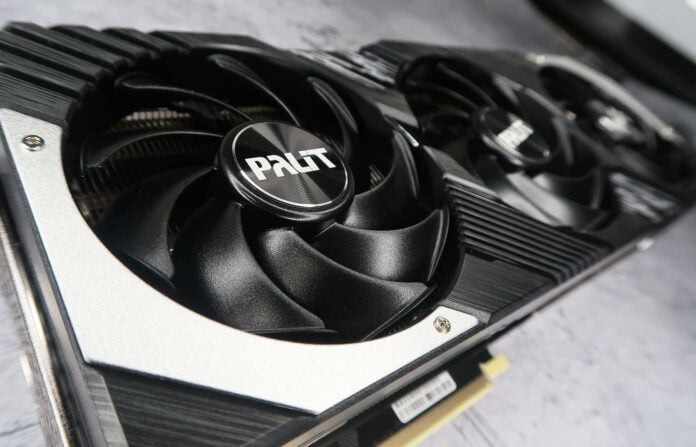Modern graphics cards tend to live in infamy. Putting aside the rather large issue of inflated prices, there are concerns of melting power connectors, faulty vapour chambers and the interminable question of whether ray tracing is as important as pure rasterisation. Such topics have dominated recent launches, yet few new GPUs have stoked controversy quite like today’s GeForce RTX 4070 Ti.
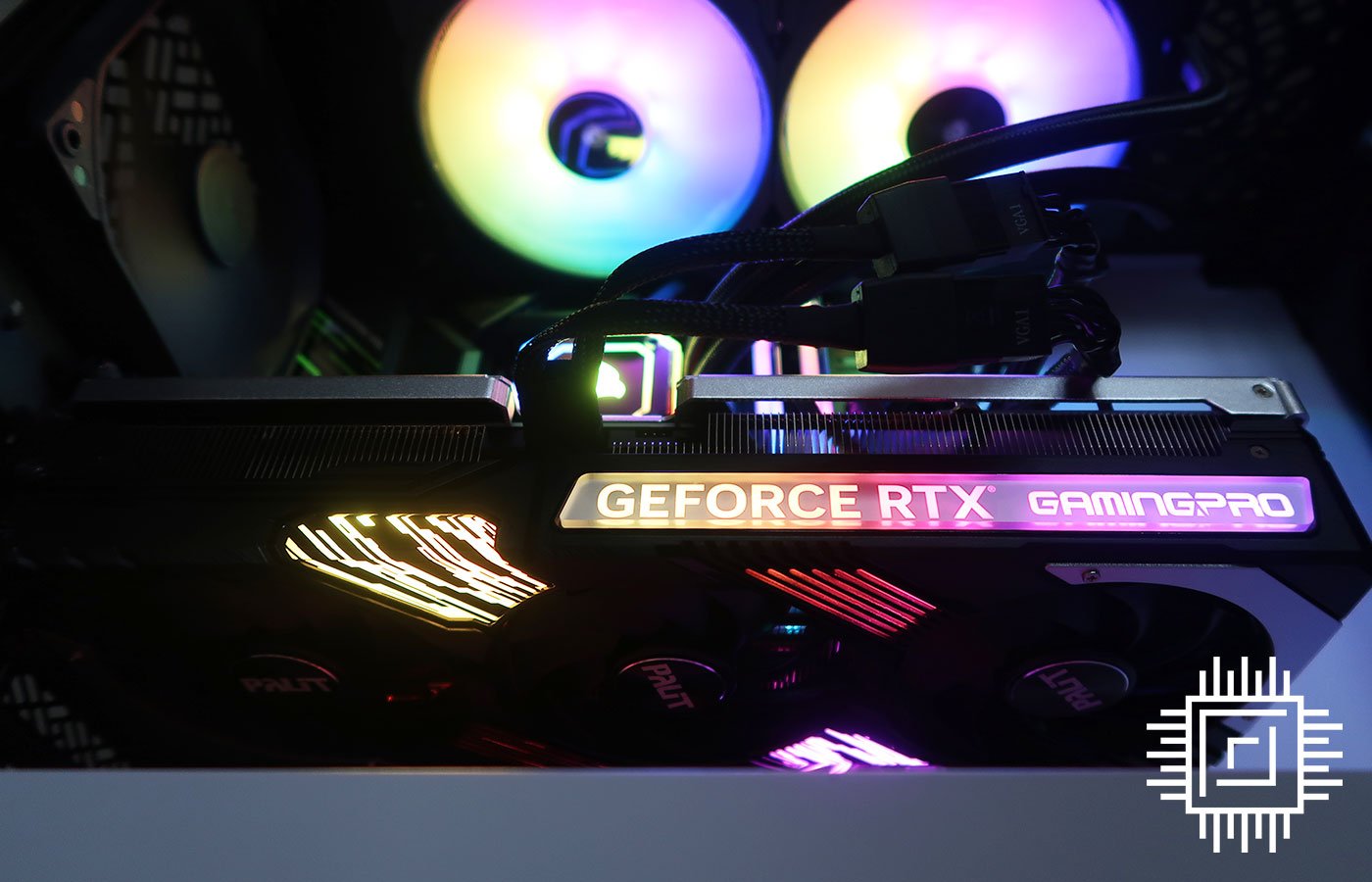

Palit GeForce RTX 4070 Ti GamingPro
£799 / $799
Pros
- Delivers on 2K120 promise
- RT and DLSS 3 perks
- Ultra cool, extra quiet
- Single power connector
- Relatively low power draw
Cons
- Only 12GB memory
- $799 x70 Series GPU
Club386 may earn an affiliate commission when you purchase products through links on our site.
How we test and review products.
Cast your memory back to last September and you’ll recall Nvidia’s next-generation strategy for its best graphics cards comprised RTX 4090 ($1,599), RTX 4080 16GB ($1,199) and RTX 4080 12GB ($899). Nothing particularly untoward, or so it seemed, until we revealed the most affordable card was losing much more than just 4GB of memory. All three models, it turned out, use unique GPUs – AD102, AD103 and AD104, respectively – and it was disingenuous of Nvidia to market the latter as an x80 Series product, irrespective of perceived performance.
Cue Internet backlash and, just weeks after the initial announcement, Nvidia made the unprecedented decision to cancel RTX 4080 12GB, claiming it “a fantastic graphics card, but it’s not named right.” Speculation over AD104’s future grew rampant, yet to the surprise of few, third-place Ada Lovelace GPU resurfaces in early 2023 as an x70 Series product.
A lot can happen in the graphics arena in a short space of time. A swift name change to RTX 4070 Ti is but one obstacle for Nvidia to navigate, as other hurdles have since surfaced in the form of Radeon RX 7900 XTX and RX 7900 XT. Priced at $999 and $899, respectively, the RDNA 3 duo delivers a performance punch that brings much-needed competition to the high-end market.
And there are other significant headwinds to factor in. Pandemic and mining-fuelled booms have collapsed, and plummeting GPU shipments coupled with a growing cost-of-living crisis intimates the days of exorbitant markups are coming to an end. RTX 4080 bucked the recent trend of sold-out GPUs with plentiful stock on store shelves immediately after launch, and Nvidia responds to these challenges with an RTX 4070 Ti price cut from the get-go.
Rather than launch at the same $899 price point originally mooted for RTX 4080 12GB, the rebranded GPU gets an 11 per cent chop and arrives at a more attractive $799 MSRP. Let’s revisit the Club386 Table of Doom to see how AD104 stacks up.
Table of Doom
| GeForce | RTX 4090 | RTX 4080 | 12GB RTX 4070 TI | RTX 3090 Ti | RTX 3080 Ti | RTX 3080 12GB |
|---|---|---|---|---|---|---|
| Launch date | Oct 2022 | Nov 2022 | Jan 2023 | Mar 2022 | Jun 2021 | Jan 2022 |
| Codename | AD102 | AD103 | AD104 | GA102 | GA102 | GA102 |
| Architecture | Ada Lovelace | Ada Lovelace | Ada Lovelace | Ampere | Ampere | Ampere |
| Process (nm) | 4 | 4 | 4 | 8 | 8 | 8 |
| Transistors (bn) | 76.3 | 45.9 | 35.8 | 28.3 | 28.3 | 28.3 |
| Die size (mm2) | 608.5 | 378.6 | 294.5 | 628.4 | 628.4 | 628.4 |
| SMs | 128 of 144 | 76 of 80 | 60 of 60 | 84 of 84 | 80 of 84 | 70 of 84 |
| CUDA cores | 16,384 | 9,728 | 7,680 | 10,752 | 10,240 | 8,960 |
| Boost clock (MHz) | 2,520 | 2,505 | 2,610 | 1,860 | 1,665 | 1,710 |
| Peak FP32 TFLOPS | 82.6 | 48.7 | 40.1 | 40.0 | 34.1 | 30.6 |
| RT cores | 128 | 76 | 60 | 84 | 80 | 70 |
| RT TFLOPS | 191.0 | 112.7 | 92.7 | 78.1 | 66.6 | 59.9 |
| Tensor cores | 512 | 304 | 240 | 336 | 320 | 280 |
| ROPs | 176 | 112 | 80 | 112 | 112 | 96 |
| Texture units | 512 | 304 | 240 | 336 | 320 | 280 |
| Memory size (GB) | 24 | 16 | 12 | 24 | 12 | 12 |
| Memory type | GDDR6X | GDDR6X | GDDR6X | GDDR6X | GDDR6X | GDDR6X |
| Memory bus (bits) | 384 | 256 | 192 | 384 | 384 | 384 |
| Memory clock (Gbps) | 21 | 22.4 | 21 | 21 | 19 | 19 |
| Bandwidth (GB/s) | 1,008 | 717 | 504 | 1,008 | 912 | 912 |
| L1 cache (MB) | 16 | 9.5 | 7.5 | 10.5 | 10 | 8.8 |
| L2 cache (MB) | 72 | 64 | 48 | 6 | 6 | 6 |
| Power (watts) | 450 | 320 | 285 | 450 | 350 | 350 |
| Launch MSRP ($) | 1,599 | 1,199 | 1,999 | 1,199 | 799 |
As we all know, GPUs are designed to scale and massage multiple price points. Top-end AD102 is a monster, and sets the stage magnificently, yet any architecture worth its salt needs to extend effectively down the stack.
AD104, pictured below in block diagram form and productised as GeForce RTX 4070 Ti, brings sweeping cuts to just about every facet. A full quota of 60 SMs translates to 7,680 CUDA cores operating at a heightened 2,610MHz. Extra frequency never hurts, yet the magnitude of the chop is reflected by the fact RTX 4070 Ti features less than half the core count of flagship RTX 4090, and over 20 per cent less than RTX 4080.
RT and Tensor cores drop accordingly, and the less-of-everything approach is equally savage at the back end, where memory capacity is reduced to 12GB of GDDR6X and bus width narrowed to 192 bits. At the default 21Gbps, we’re looking at 504GB/s of bandwidth, representing a near-30 per cent reduction over RTX 4080. Such brutal cuts are mitigated somewhat by the Ada architecture carrying more onboard cache – there’s less need to routinely spool out to memory – yet a card with only 12GB of RAM can’t truly be deemed 4K-ready in 2023.
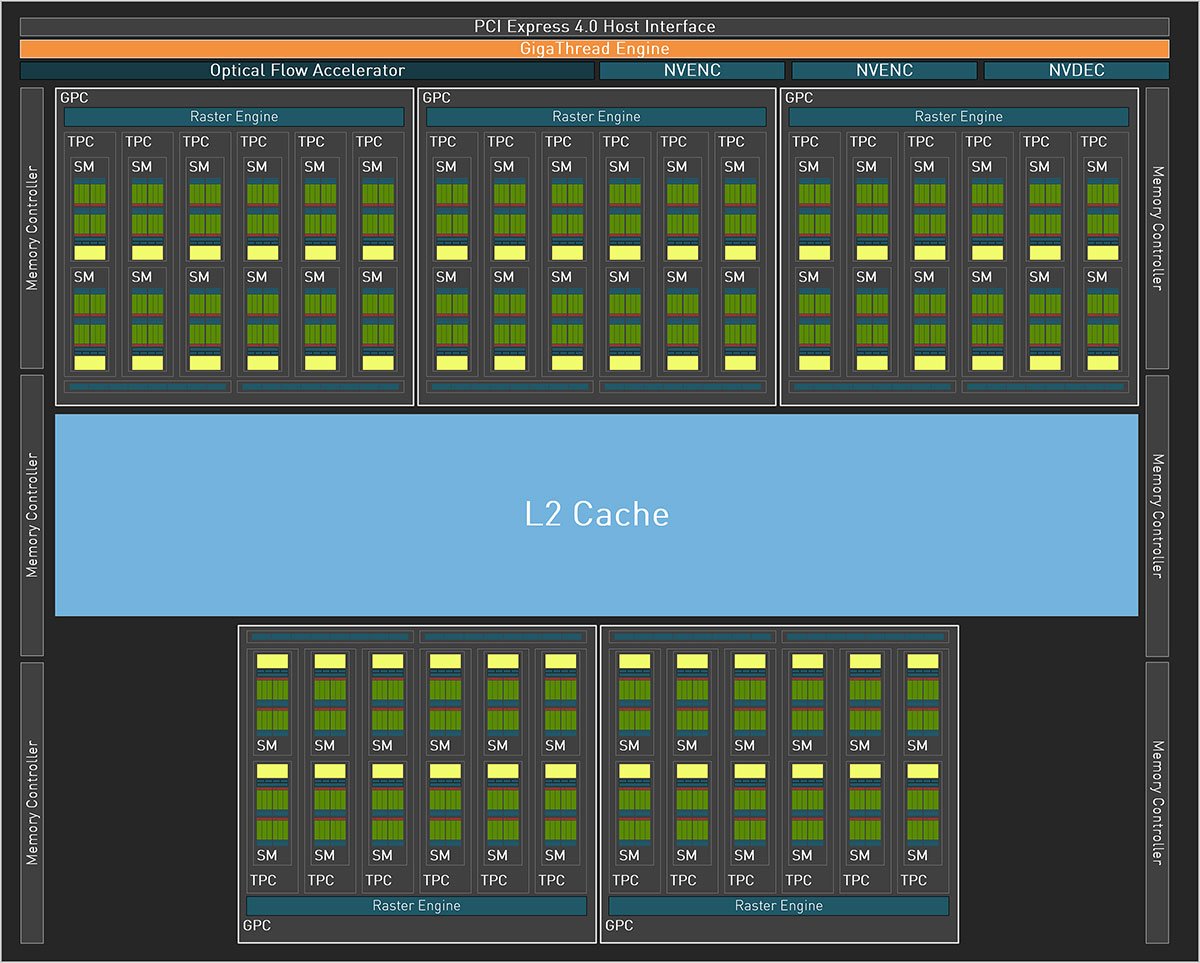
QHD is instead the primary focus, with Nvidia specifically marketing RTX 4070 Ti as a means of achieving over 120 frames per second at an increasingly common 1440p resolution. Such positioning decreases the overall cost of ownership and also has the benefit of lower running costs. While RTX 4090 maintained the same lofty 450W TGP as RTX 3090 Ti, RTX 4070 Ti sips a mere 285W. That’s nearly 20 per cent lower than the last-generation x80 equivalent.
AD104 GPUs that don’t quite make the cut may one day be repurposed for the mid-range – a pared-down, non-Ti RTX 4070 will surely see the light of day – but the question for today’s review is whether or not full-fat RTX 4070 Ti does enough to justify a reduced $799 fee amid renewed competition. Nvidia will argue RTX 4070 Ti offers RTX 3090 Ti-like performance for less than half the price, with the added bonus of latest-gen ray tracing supremacy and DLSS enhancements. That much is true, but it won’t have escaped the attention of PC gamers that previous-generation RTX 3070 Ti launched at $599.
Pricing will inevitably lead to fierce debate in tech circles – onlookers are already concerned that a $799 RTX 3070 Ti paves the way for a $599 RTX 3060 – and there’s no denying that rampant price inflation of recent years has had a lasting effect on the GPU market whether your allegiance is Green or Red. PC gaming fans have every right to be concerned as previously attainable product lines move out of reach, and much like the smartphone market, shocking premium price tags have quickly transitioned to the norm.
Nvidia’s army of partners will be hoping for a positive reaction as, for the first time on a 40 Series card, there’s no Founders Edition to compete with. RTX 4070 Ti is only available from add-in-board partners, many of whom have at least half-a-dozen unique SKUs to choose from.
Palit GeForce RTX 4070 Ti GamingPro
The first card to pass through the Club386 labs is Palit’s GamingPro. Typically among the manufacturer’s more affordable options, GamingPro designs shun the bells and whistles of GameRock cards in favour of more sedate designs intended to stick as close to the $799/£799 MSRP as possible. An important distinction given that rival Radeon RX 7900 XT cards are in stock and available to purchase at £899 here on UK shores.
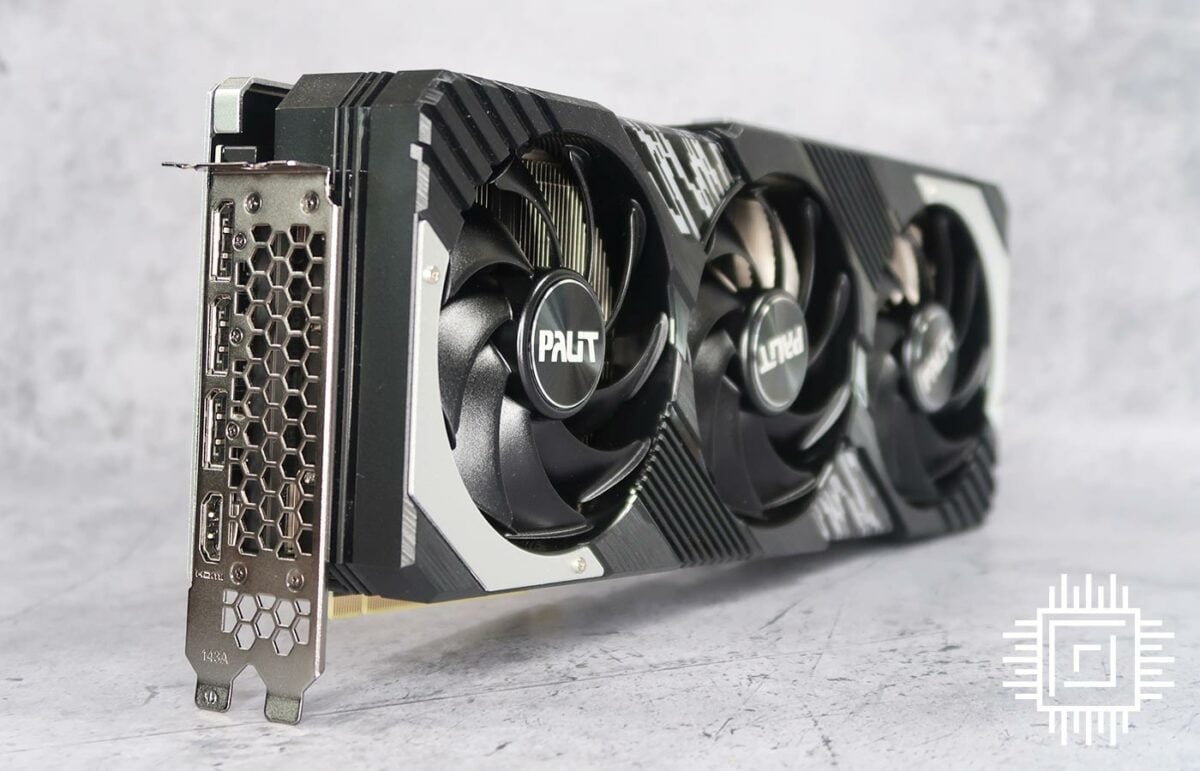
In terms of the card itself, RTX 4070 Ti GamingPro remains a meaty unit irrespective of TDP. Wrapped around that 285W GPU is a massive cooler measuring 328mm long and 63mm wide. Palit’s design occupies a full three slots, stands noticeably taller than the I/O plate, and tips the scales at a hefty 1,539g. Given the weight and propensity to sag, it’s a shame a support bracket isn’t included in the bundle.
RTX 4070 Ti coolers absolutely do not need to be this expansive, yet going big on size does translate to cool operating temps and ultra-low noise. GamingPro is impressively quiet, with the trio of 92mm fans barely having to break sweat in keeping the GPU in check. All three switch off when core temperature drops below 40°C, ensuring silence at low load, and the transition from off to on is suitably smooth.
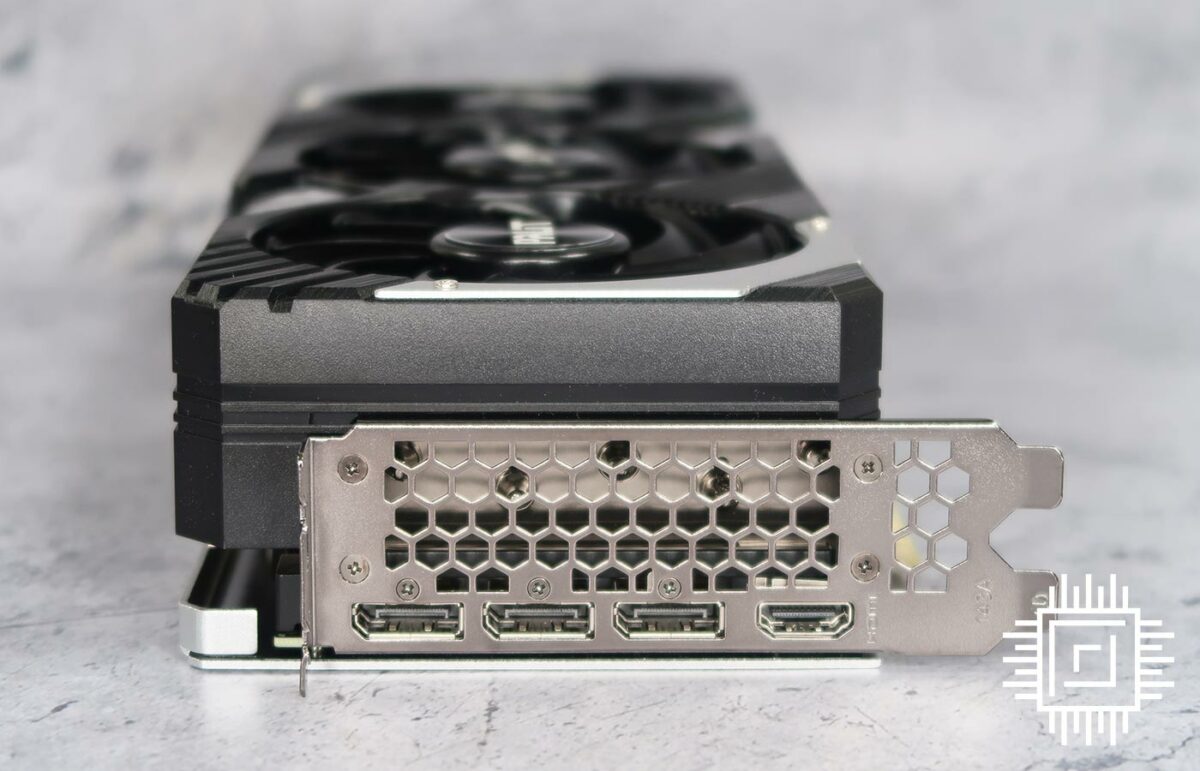
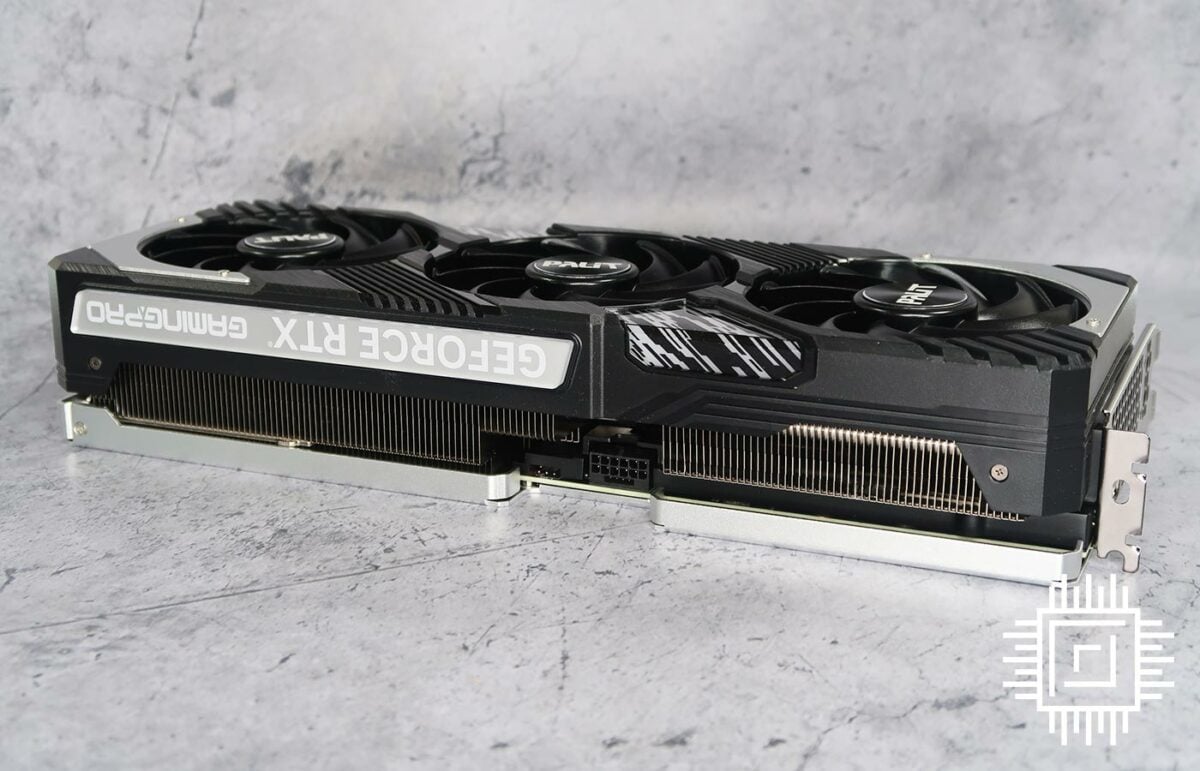
Display outputs, as expected, conform to the familiar mandate of one DisplayPort 1.4a and three HDMI 2.1. Palit’s full-length backplate gives the board decent rigidity, and though the plastic front shroud does show signs of flex, the card as a whole feels solid and well put together.
What’s interesting is the location of the single 16-pin 12VHPWR connector, which sits nearer the front than the back. The positioning is reflective of how short the underlying PCB really is; it measures just 170mm in length, meaning the cooler overhangs by a whopping 93 per cent. An enterprising AIB will surely create a mini-ITX variant, one would think.
Such bulk intimates a factory overclock and Palit obliges by raising boost clock from 2,610MHz to a dizzy 2,760MHz. That’s what it says on the tin, mind you, as the review sample would routinely hit 2,865MHz inside our real-world test platform. From what we’ve seen of partner cards thus far, this is about as quick as it’s going to get. 12GB of memory, meanwhile, remains stock clocked at an effective 21Gbps.
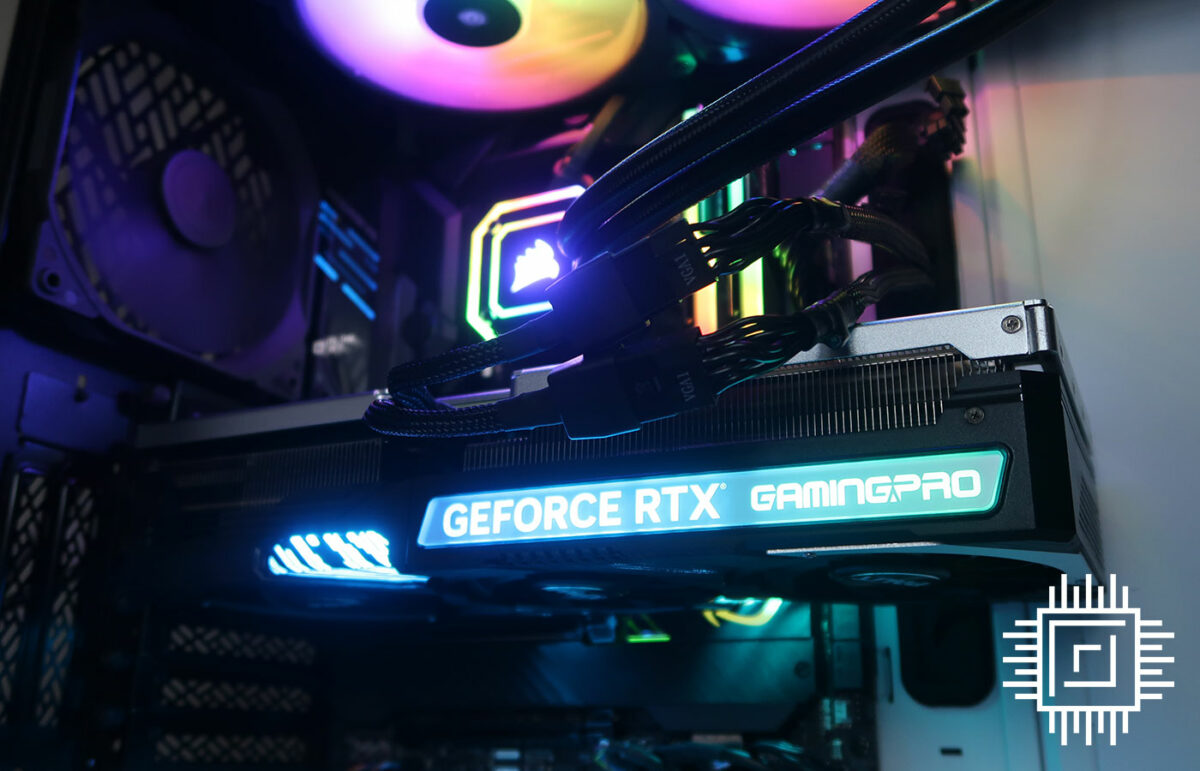
Palit has upped its game in the lighting department this generation, too, and though GamingPro lacks the wow factor of GameRock, the RGB still works well. Backlit camo sections flanking the fans bode well for a vertical installation, while the GeForce RTX GamingPro branding across the top shines true in a traditional horizontal orientation. Seamless lighting effects echo plenty of LEDs and good diffusion, and a three-pin aRGB header resides alongside the power connector for motherboard synchronisation.
Said cable is included in the box, as is a two-way, eight-pin PCIe adapter for those who haven’t yet made the transition to an ATX 3.0 power supply. Almost time for the benchmarks numbers you’ve been waiting for, but first, a quick recap on all that’s good about Nvidia’s Ada Lovelace architecture.
Ada Optimisations
While a shift to a smaller node affords more transistor firepower, such a move typically precludes sweeping changes to architecture. Optimisations and resourcefulness are order of the day, and the huge computational demands of raytracing are such that raw horsepower derived from a 3x increase in transistor budget isn’t enough; something else is needed, and Ada Lovelace brings a few neat tricks to the table.
Nvidia often refers to raytracing as a relatively new technology, stressing that good ol’ fashioned rasterisation has been through wave after wave of optimisation, and such refinement is actively being engineered for RT and Tensor cores. There’s plenty of opportunity where low-hanging fruit is yet to be picked.
Shader Execution Reordering
Shaders have been running efficiently for years, whereby one instruction is executed in parallel across multiple threads. You may know it as SIMT.
Raytracing, however, throws a spanner in those smooth works, as while pixels in a rasterised triangle lend themselves to running concurrently, keeping all lanes occupied, secondary rays are divergent by nature and the scattergun approach of hitting different areas of a scene leads to massive inefficiency through idle lanes.

Ada’s fix, dubbed Shader Execution Reordering (SER), is a new stage in the raytracing pipeline tasked with scanning individual rays on the fly and grouping them together. The result, going by Nvidia’s internal numbers, is a 2x improvement in raytracing performance in scenes with high levels of divergence.
Nvidia portentously claims SER is “as big an innovation as out-of-order execution was for CPUs.” A bold statement and there is a proviso in that Shader Execution Reordering is an extension of Microsoft’s DXR APIs, meaning it us up to developers to implement and optimise SER in games.
There’s no harm in having the tools, mind, and Nvidia is quickly discovering that what works for rasterisation can evidently be made to work for RT.
Upgraded RT Cores
In the rasterisation world, geometry bottlenecks are alleviated through mesh shaders. In a similar vein, displaced micro-meshes aim to echo such improvements in raytracing.
“The era of brute-force graphics rendering is over”
Bryan Catanzaro, Nvidia VP of applied deep learning research
With Ampere, the Bounding Volume Hierarchy (BVH) was forced to contain every single triangle in the scene, ready for the RT core to sample. Ada, in contrast, can evaluate meshes within the RT core, identifying a base triangle prior to tessellation in an effort to drastically reduce storage requirements.
A smaller, compressed BVH has the potential to enable greater detail in raytraced scenes with less impact on memory. Having to insert only the base triangles, BVH build times are improved by an order of magnitude and data sizes shrink significantly, helping reduce CPU overhead.
The sheer complexity of raytracing is such that eliminating unnecessary shader work has never been more important. To that end, an Opacity Micromap Engine has also been added to Ada’s RT core to reduce the amount of information going back and forth to shaders.
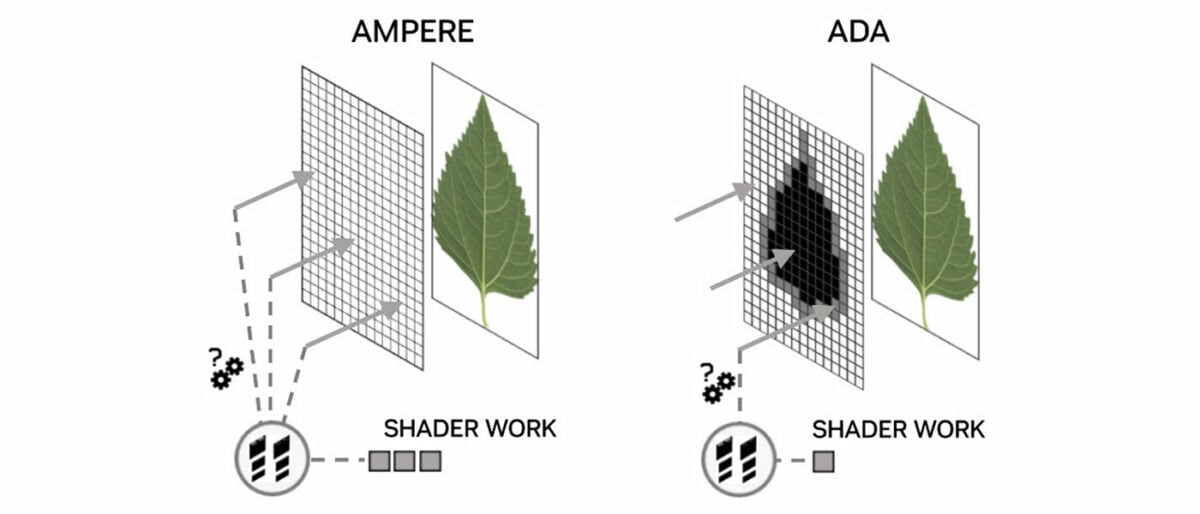
In the common leaf example, developers place the texture of foliage within a rectangle and use opaque polygons to determine the leaf’s position. A way to construct entire trees efficiently, yet with Ampere the RT core lacked this basic ability, with all rays passed back to the shader to determine which areas are opaque, transparent, or unknown. Ada’s Opacity Micromap Engine can identify all the opaque and transparent polygons without invoking any shader code, resulting in 2x faster alpha traversal performance in certain applications.
These two new hardware units make the third-generation RT core more capable than ever before – TFLOPS per RT core has risen by ~65 per cent between generations – yet all this isn’t enough to back up Nvidia’s claims of Ada Lovelace delivering up to 4x the performance of the previous generation. For that, Team Green continues to rely on AI.
DLSS 3
Since 2019, Deep Learning Super Sampling has played a vital role in GeForce GPU development. Nvidia’s commitment to the tech is best expressed by Bryan Catanzaro, VP of applied deep learning research, who states with no uncertainty that “the era of brute-force graphics rendering is over.”
Third-generation DLSS, deemed a “total revolution in neural graphics,” expands upon DLSS Super Resolution’s AI-trained upscaling by employing optical flow estimation to generate entire frames. Through a combination of DLSS Super Resolution and DLSS Frame Generation, Nvidia reckons DLSS 3 can now reconstruct seven-eighths of a game’s total displayed pixels, to dramatically increase performance and smoothness.
Generating so much on-screen content without invoking the shader pipeline would have been unthinkable just a few years ago. It is a remarkable change of direction, but those magic extra frames aren’t conjured from thin air. DLSS 3 takes four inputs – two sequential in-game frames, an optical flow field and engine data such as motion vectors and depth buffers – to create and insert synthesised frames between working frames.
In order to capture the required information, Ada’s Optical Flow Accelerator is capable of up to 300 TeraOPS (TOPS) of optical-flow work, and that 2x speed increase over Ampere is viewed as vital in generating accurate frames without artifacts.
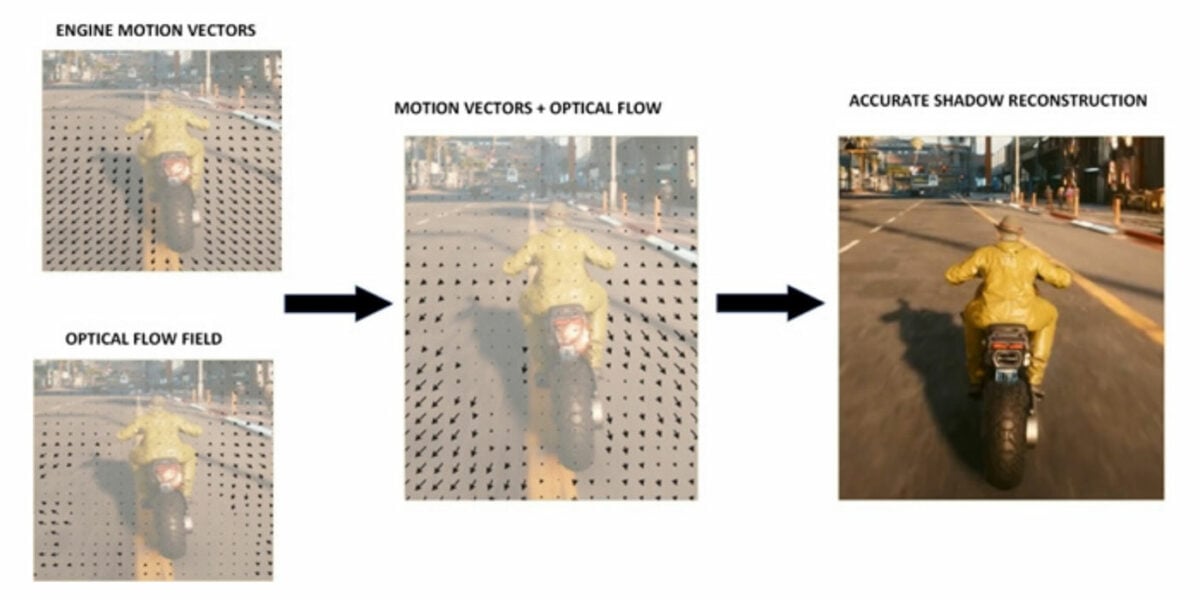
The real-world benefit of AI-generated frames is most keenly felt in games that are CPU bound, where DLSS Super Resolution can typically do little to help. Nvidia’s preferred example is Microsoft Flight Simulator, whose vast draw distances inevitably force a CPU bottleneck. Internal data suggests DLSS 3 Frame Generation can boost Flight Sim performance by as much as 2x.
Do note, also, that Frame Generation and Super Resolution can be implemented independently by developers. In an ideal world, gamers will have the choice of turning the former on/off, while being able to adjust the latter via a choice of quality settings.
More demanding AI workloads naturally warrant faster Tensor Cores, and Ada obliges by imbuing the FP8 Transformer Engine from HPC-optimised Hopper. Peak FP16 Tensor teraflops performance is already doubled from 320 on Ampere to 661 on Ada, but with added support for FP8, RTX 4090 can deliver a theoretical 1.3 petaflops of Tensor processing.
Plenty of bombast, yet won’t such processing result in an unwanted hike in latency? Such concerns are genuine; Nvidia has taken the decision to make Reflex a mandatory requirement for DLSS 3 implementation.
Designed to bypass the traditional render queue, Reflex synchronises CPU and GPU workloads for optimal responsiveness and up to a 2x reduction in latency. Ada optimisations and in particular Reflex are key in keeping DLSS 3 latency down to DLSS 2 levels, but as with so much that is DLSS related, success is predicated on the assumption developers will jump through the relevant hoops. In this case, Reflex markers must be added to code, allowing the game engine to feed back the data required to coordinate both CPU and GPU.
Given the often-sketchy state of PC game development, gamers are right to be cautious when the onus is placed in the hands of devs, and there is another caveat in that DLSS tech is becoming increasingly fragmented between generations.
DLSS 3 now represents a superset of three core technologies: Frame Generation (exclusive to RTX 40 Series), Super Resolution (RTX 20/30/40 Series), and Reflex (any GeForce GPU since the 900 Series). Nvidia has no immediate plans to backport Frame Generation to slower Ampere cards.
8th Generation NVENC
Last but not least, Ada Lovelace is wise not to overlook the soaring popularity of game streaming, both during and after the pandemic.
Building upon Ampere’s support for AV1 decoding, Ada adds hardware encoding, improving H.264 efficiency to the tune of 40 per cent. This, says Nvidia, allows streamers to bump their stream resolution to 1440p while maintaining the same bitrate.
AV1 support also bodes well for professional apps – DaVinci Resolve is among the first to announce compatibility – and Nvidia extends this potential on high-end RTX 40 Series GPUs by ensuring both launch models include dual 8th Gen NVENC encoders (enabling 8K60 capture and 2x quicker exports) as well as a 5th Gen NVDEC decoder as standard.
Performance
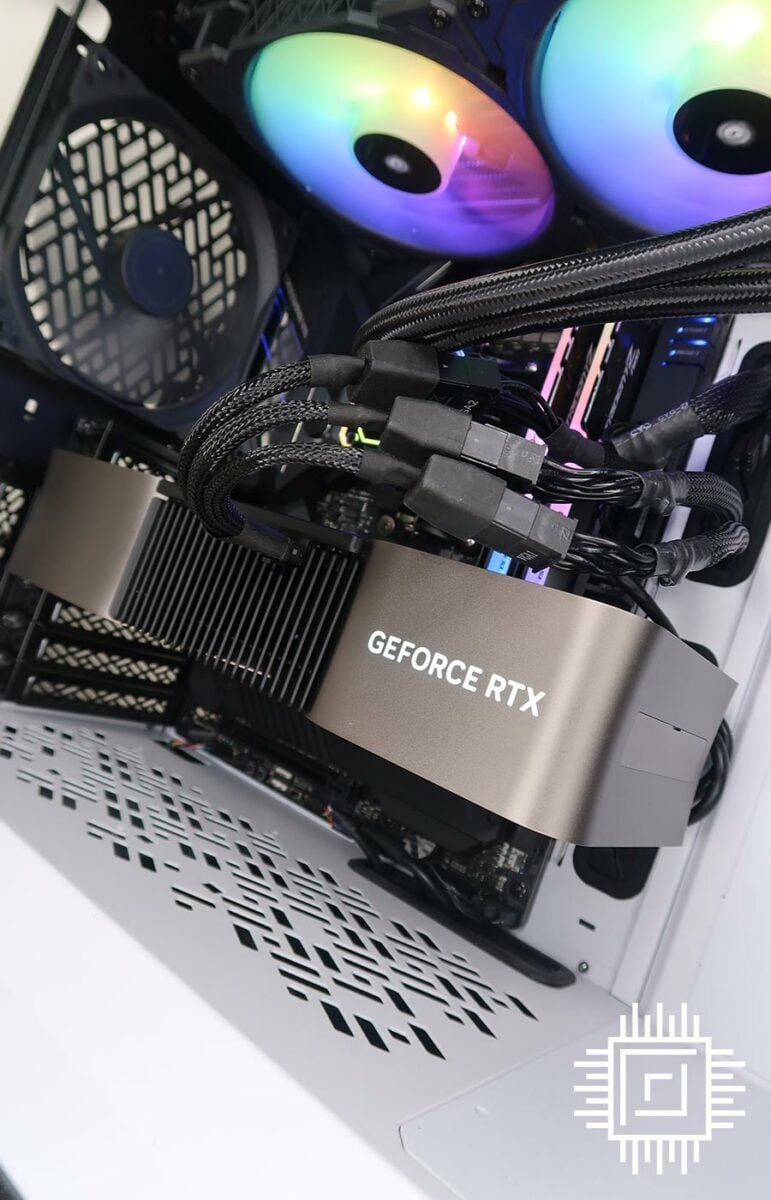
Our 5950X Test PCs
Club386 carefully chooses each component in a test bench to best suit the review at hand. When you view our benchmarks, you’re not just getting an opinion, but the results of rigorous testing carried out using hardware we trust.
Shop Club386 test platform components:
CPU: AMD Ryzen 9 5950X
Motherboard: Asus ROG X570 Crosshair VIII Formula
Cooler: Corsair Hydro Series H150i Pro RGB
Memory: 32GB G.Skill Trident Z Neo DDR4
Storage: 2TB Corsair MP600 SSD
PSU: be quiet! Straight Power 11 Platinum 1300W
Chassis: Fractal Design Define 7 Clear TG
Our trusty test platforms have been working overtime these past few months, and though the PCIe slot is starting to look worse for wear, the twin AM4 rigs haven’t skipped a beat.
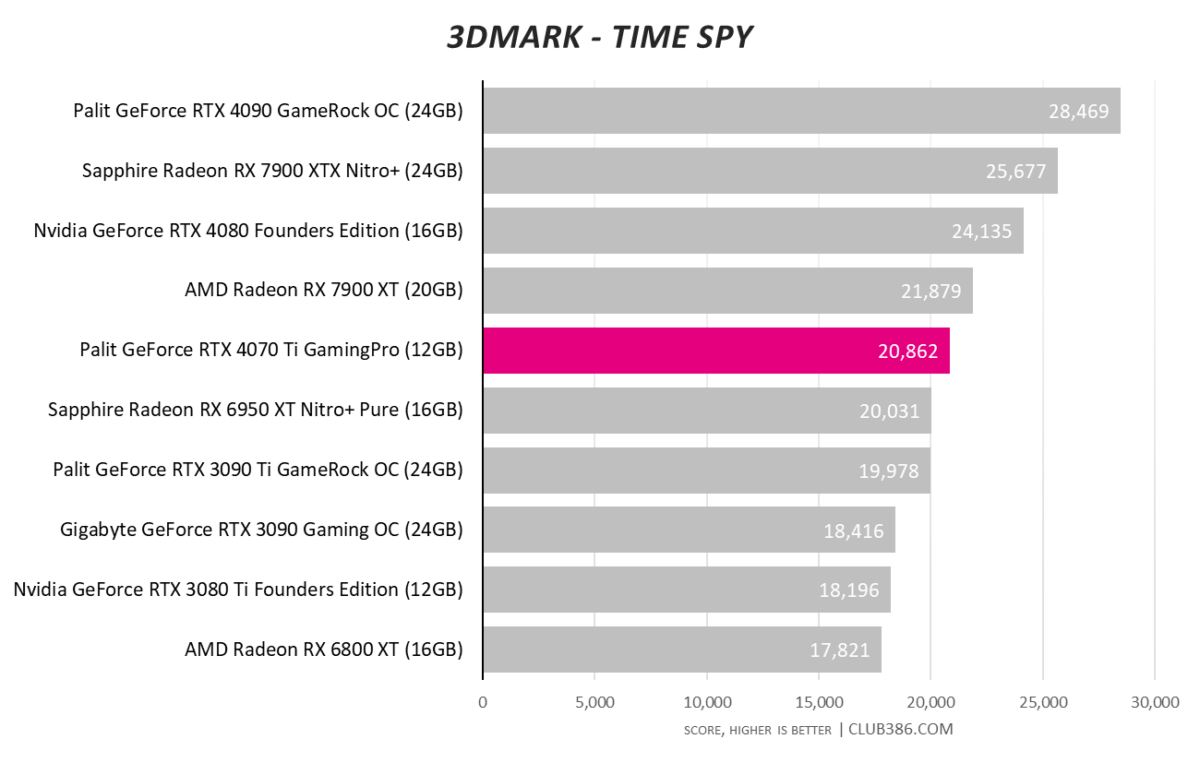
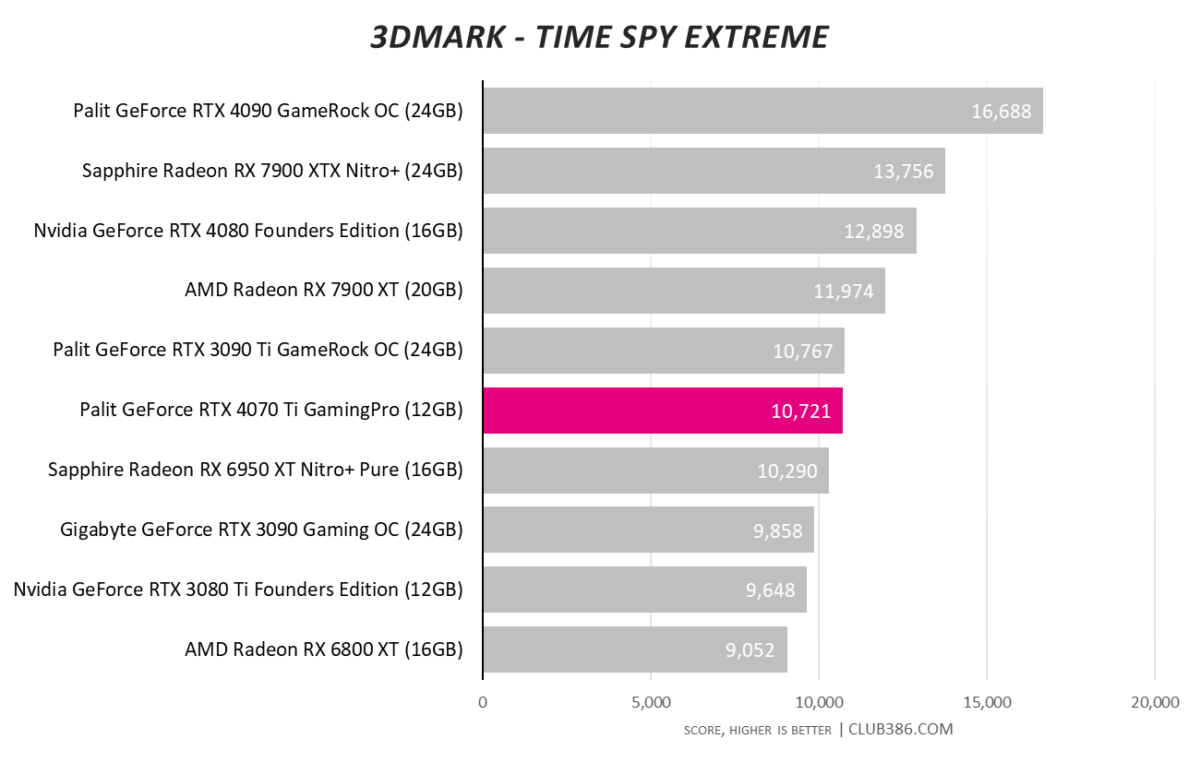
There’s usually good reason for a price cut, and for RTX 4070 Ti, we suspect Radeon RX 7900 XT had a big part to play in the $799 MSRP. Going by the famed 3DMark Time Spy Extreme scores, the Nvidia GPU is practically on par with RTX 3090 Ti and just over 10 per cent slower than its immediate AMD rival. Good thing it happens to be just over 10 per cent cheaper, then.
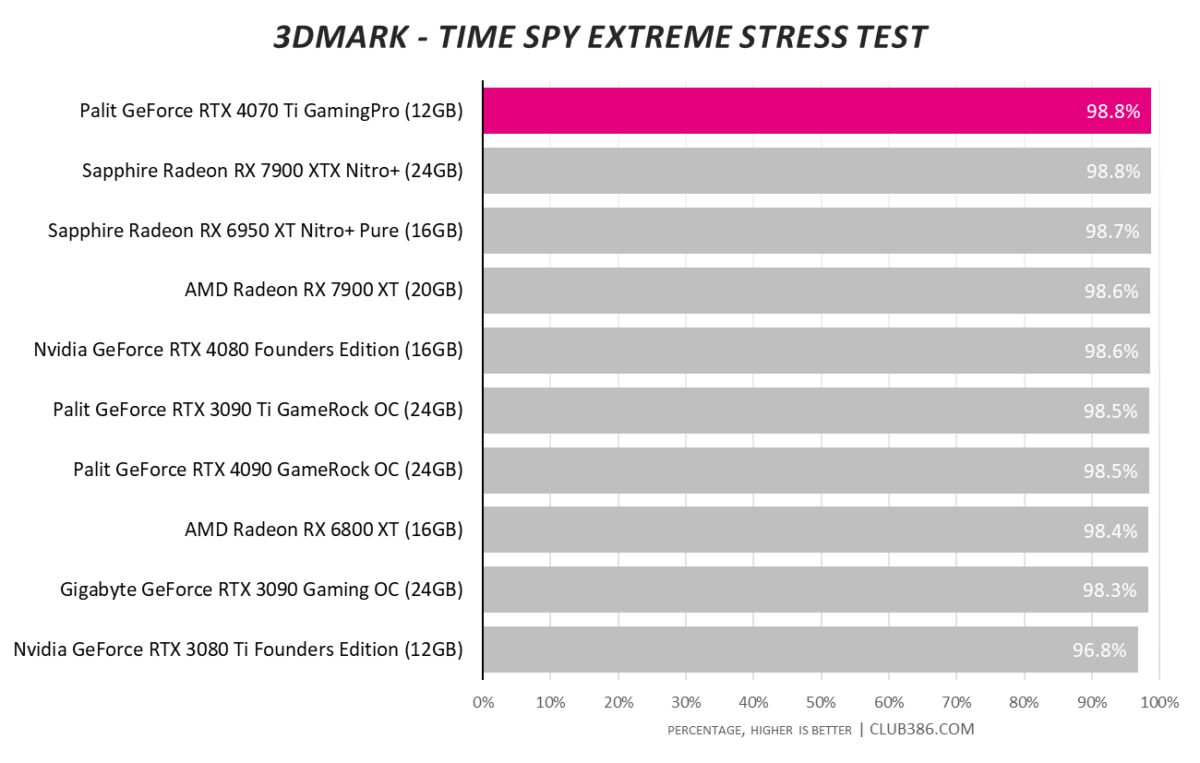
We mentioned RTX 4070 Ti partner cards need not be this big, and the proof is in testing. Palit delivers excellent consistency from an efficient 285W GPU.
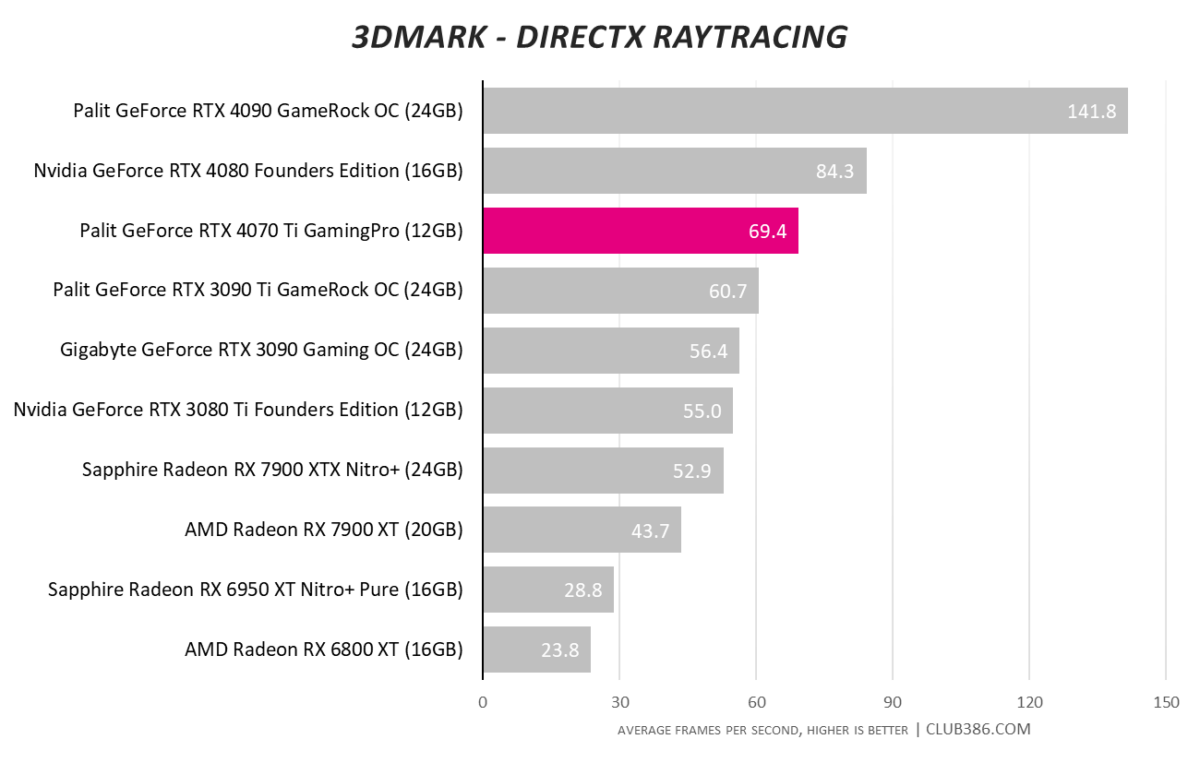
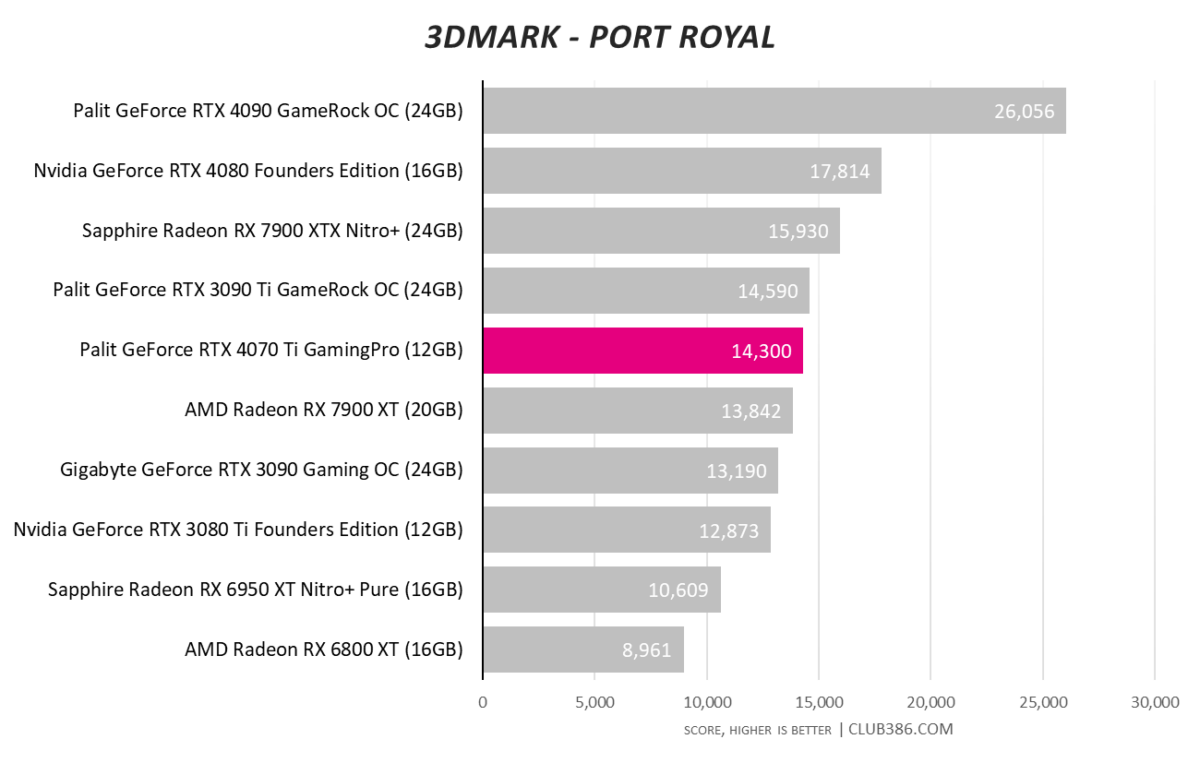
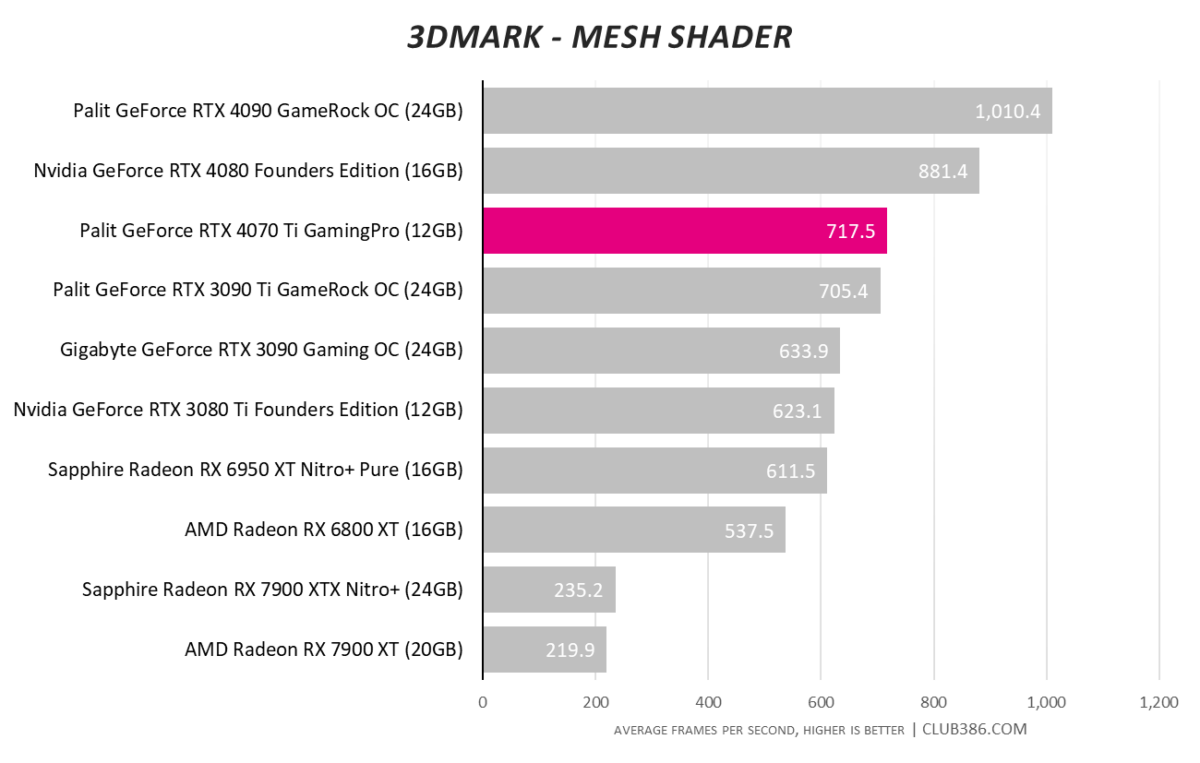
The majesty of RTX 4090 becomes all the more astonishing when lesser siblings are brought into view. RTX 4070 Ti features 53 per cent fewer RT cores than the flagship, bringing performance back down to the earthly level of previous-gen champion, RTX 3090 Ti.
We still haven’t been able to explain the low scores for RDNA 3 in the Mesh Shader test, but as expected, Nvidia maintains a healthy lead with respect to ray tracing.
Assassin’s Creed Valhalla
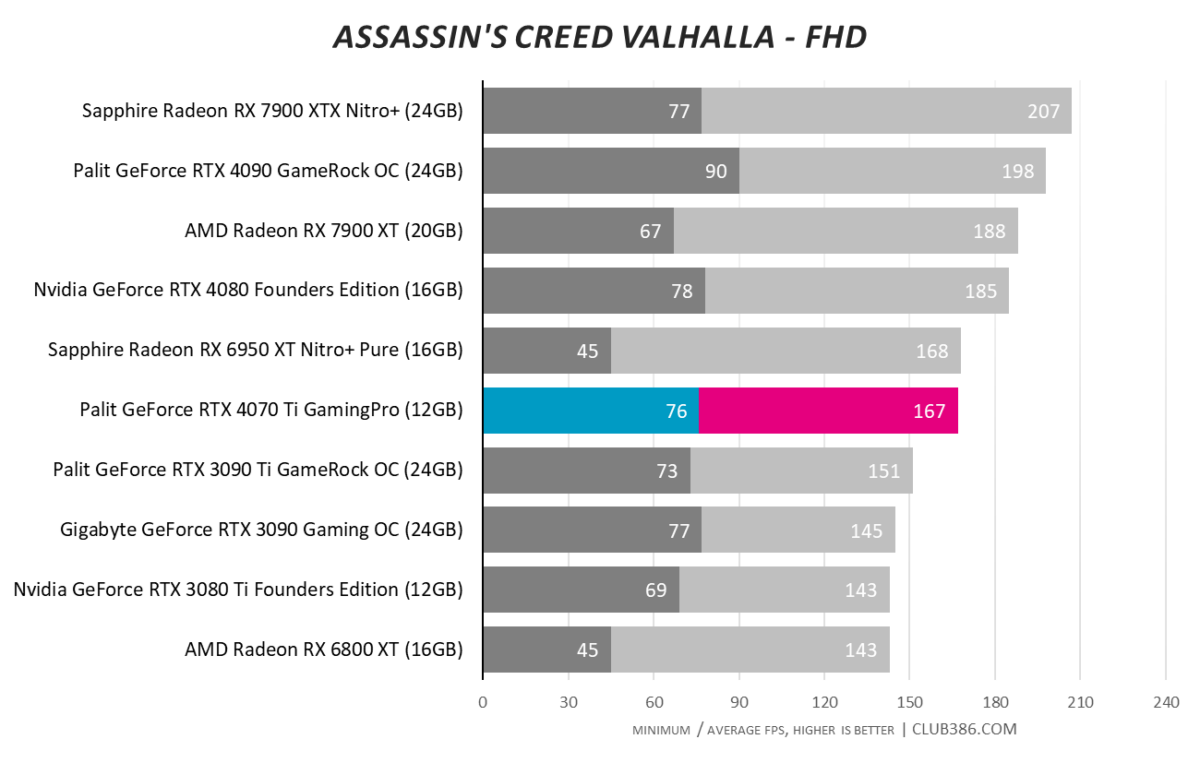
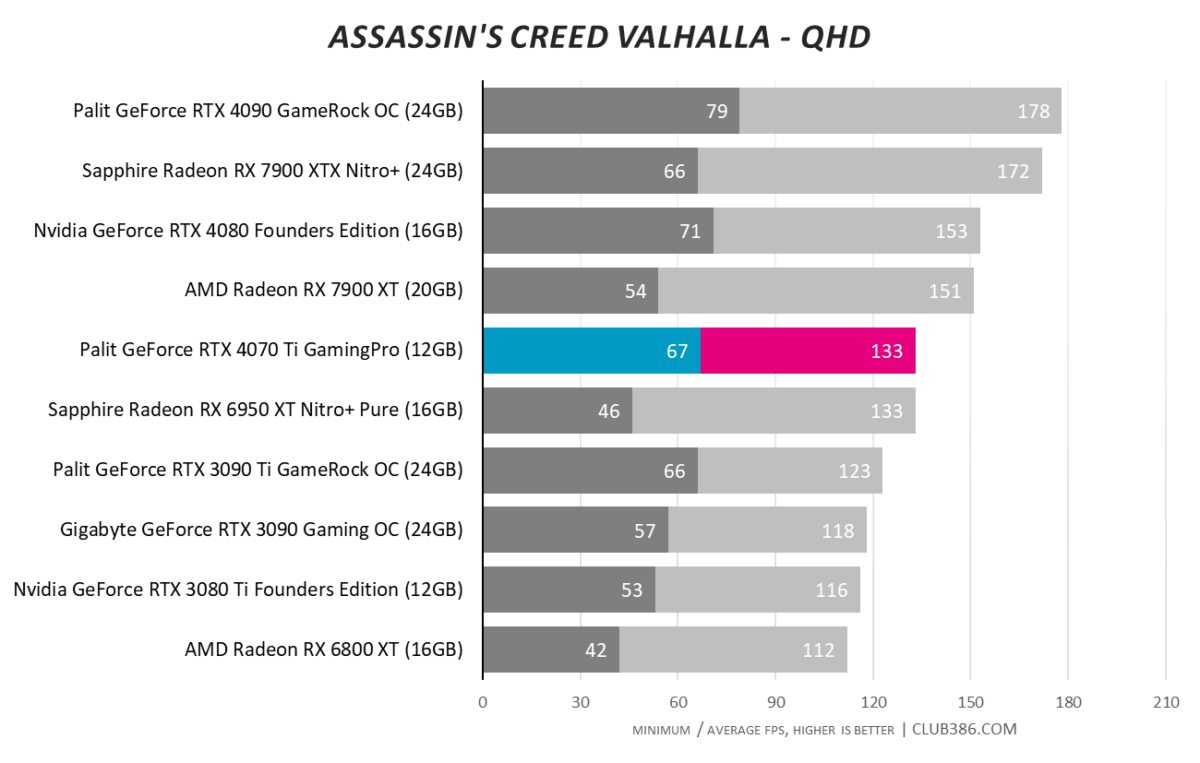
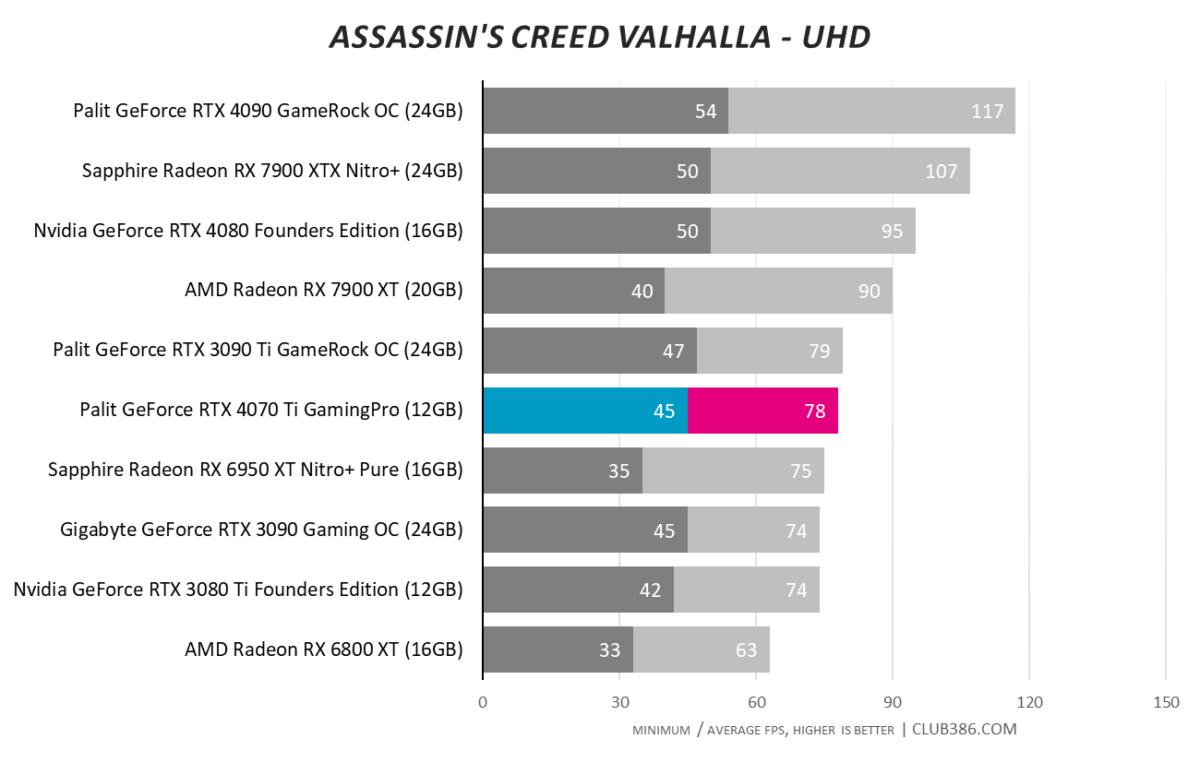
Make no mistake, stock Radeon RX 7900 XT is a thorn in RTX 4070 Ti’s side. The dearer AMD GPU is quicker than the factory-overclocked GeForce to the tune of 11 per cent at the ubiquitous 1080p resolution, and with an extra 8GB of onboard RAM, that gap grows at 1440p and 2160p.
Cyberpunk 2077
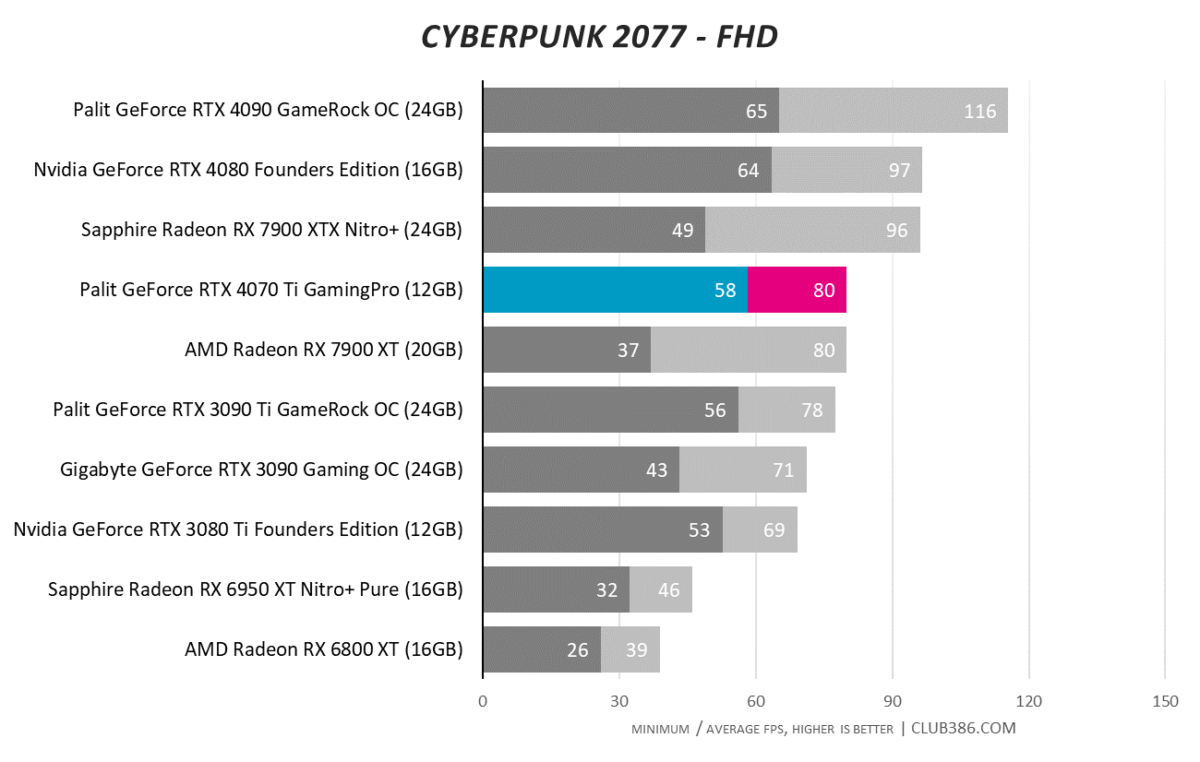
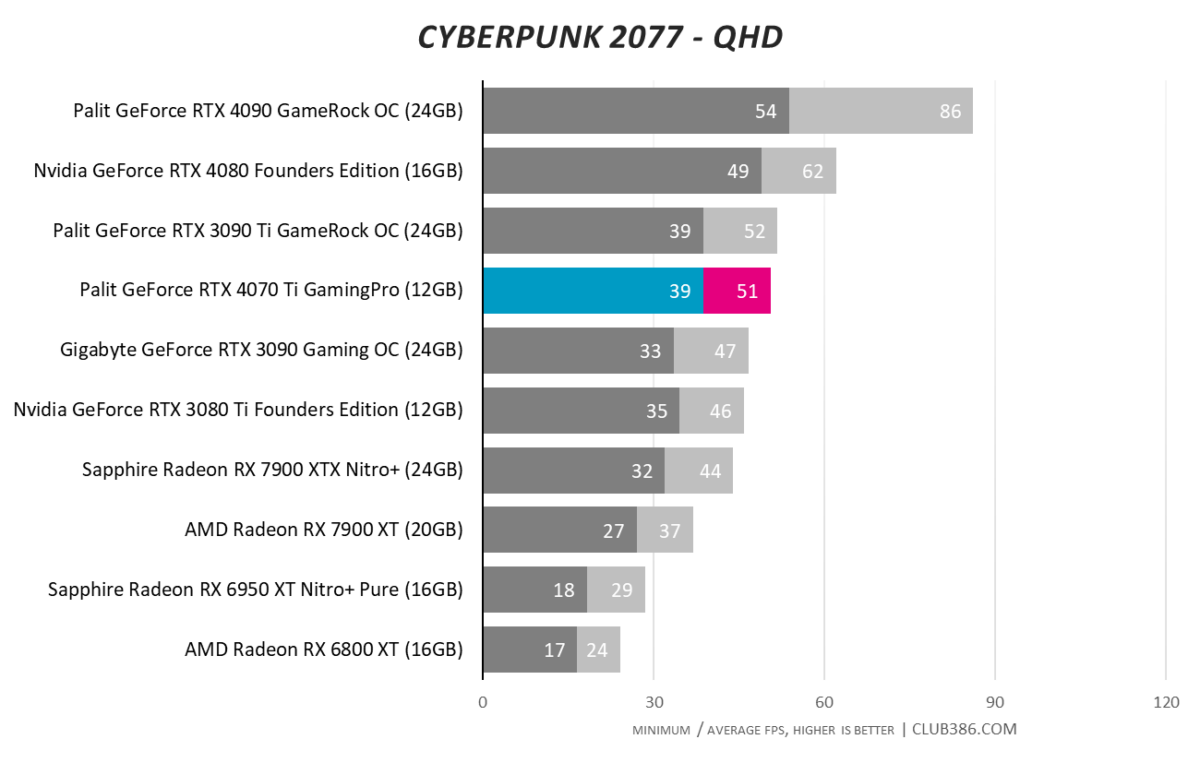
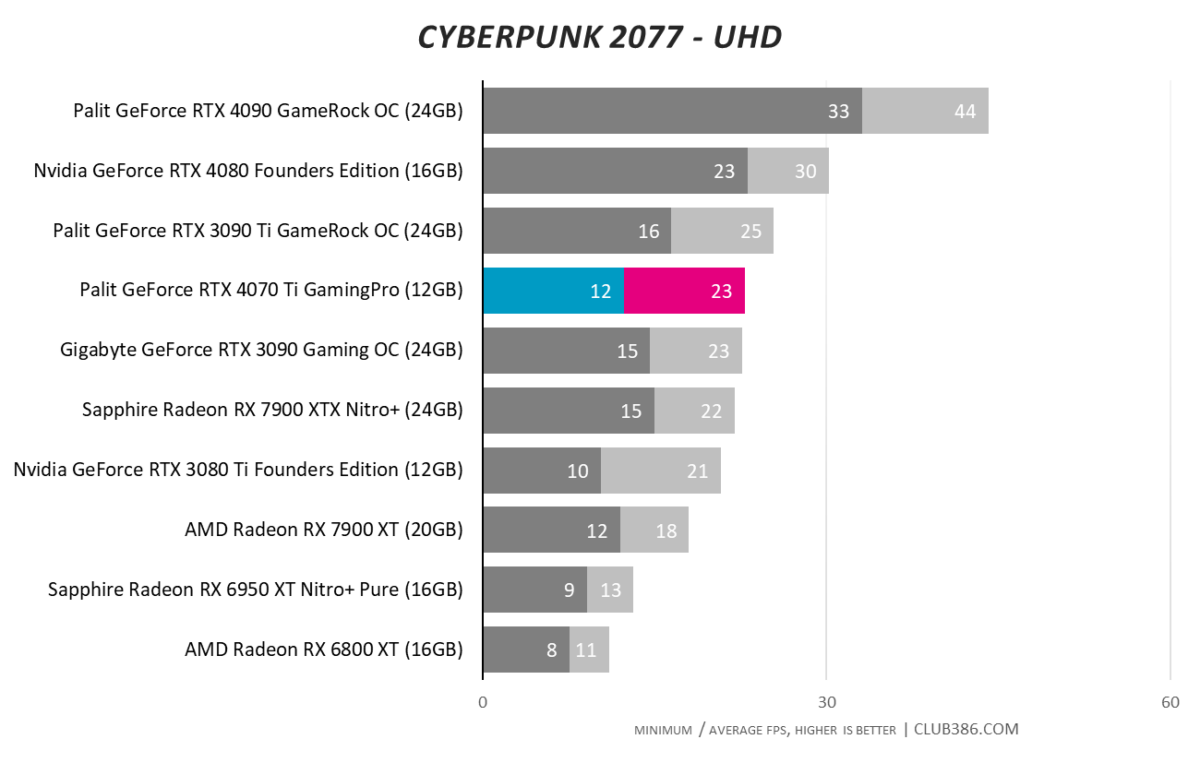
Do you measure performance with an emphasis on pure rasterisation or forward-looking ray tracing smarts? If it’s the latter, RTX 4070 Ti is a solid option for high-quality QHD gameplay.
Far Cry 6
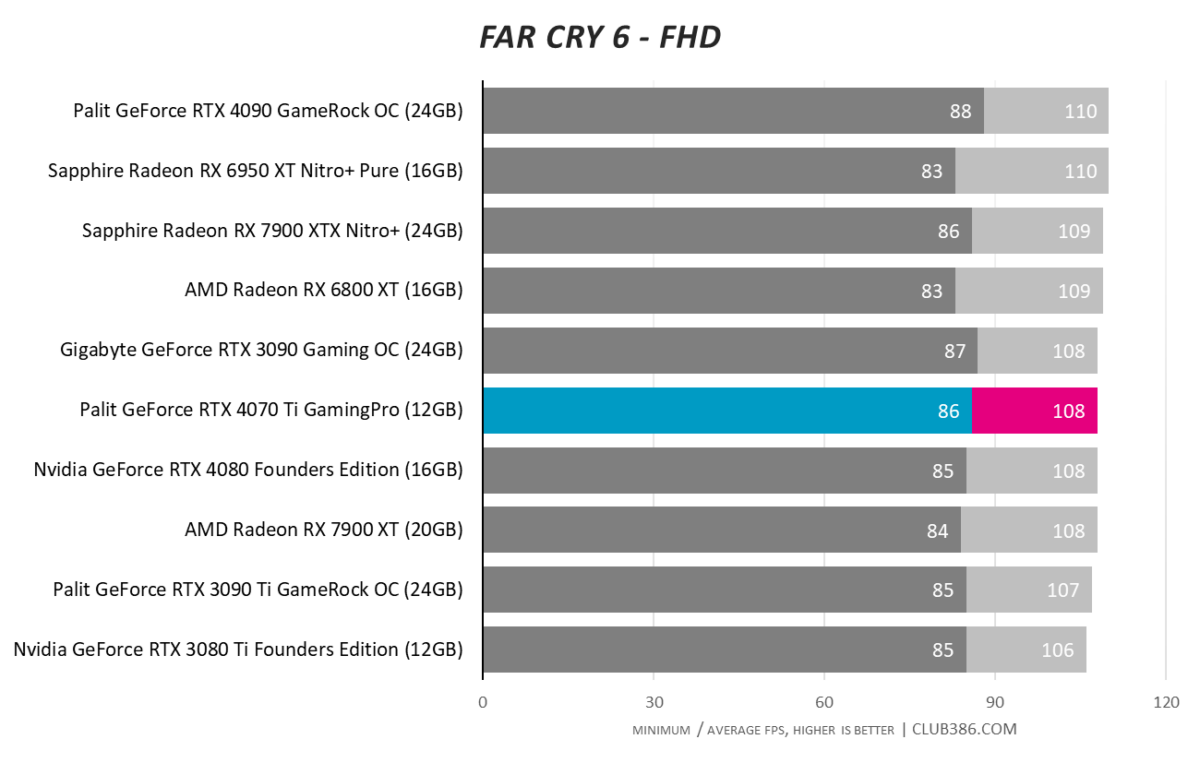
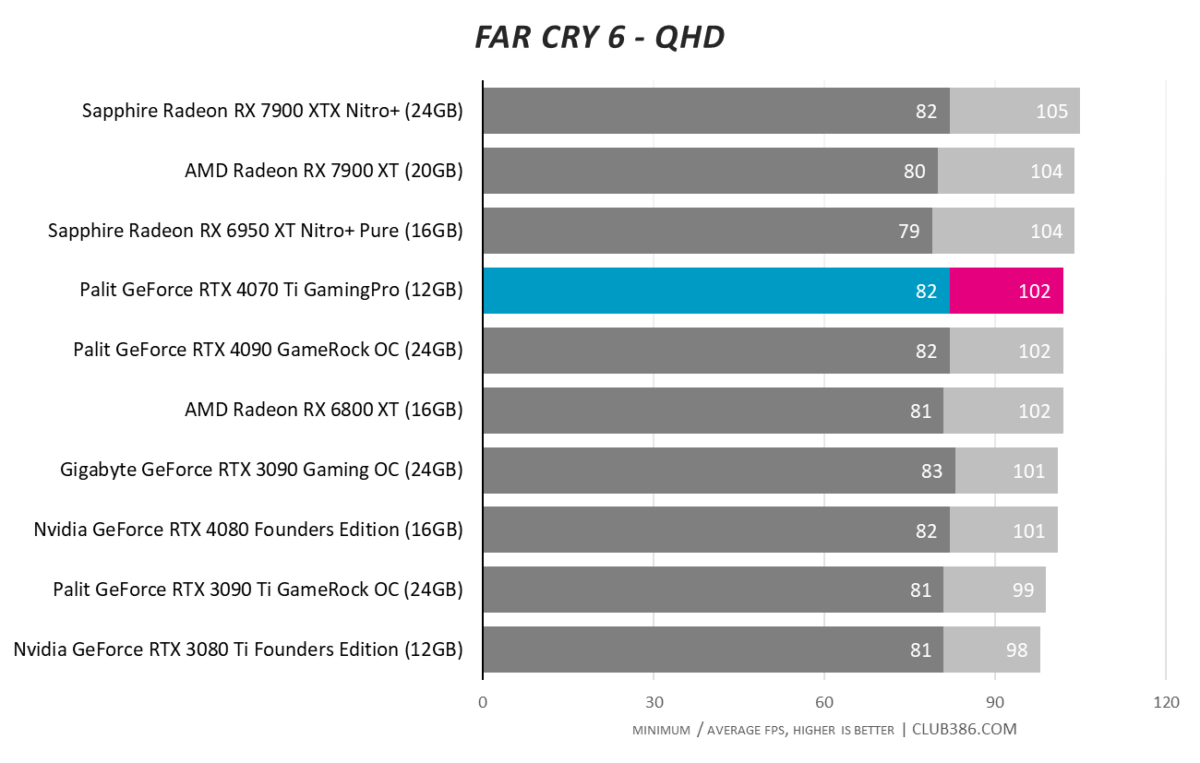
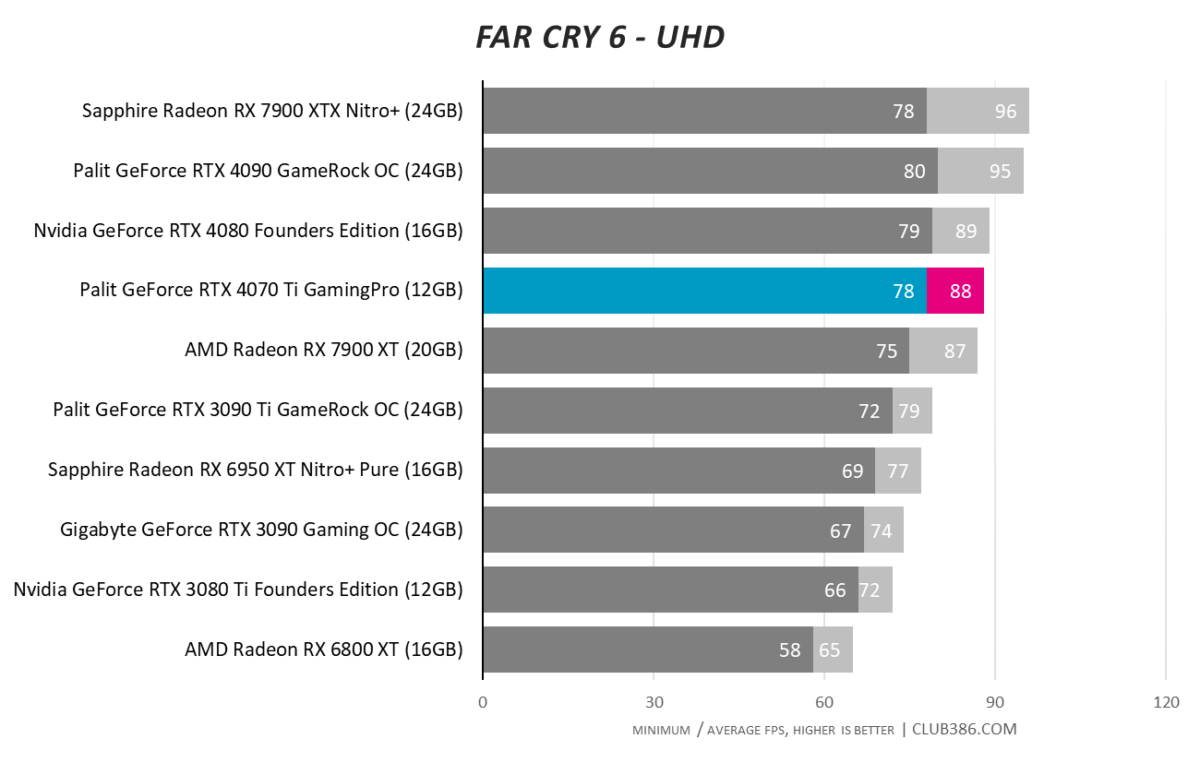
RX 7900 XT at £899 or RTX 4070 Ti at £799? There’s little to separate the two here, and consumers will be hoping for a good ol’ fashioned price war. God knows we need it.
Final Fantasy XIV: Endwalker
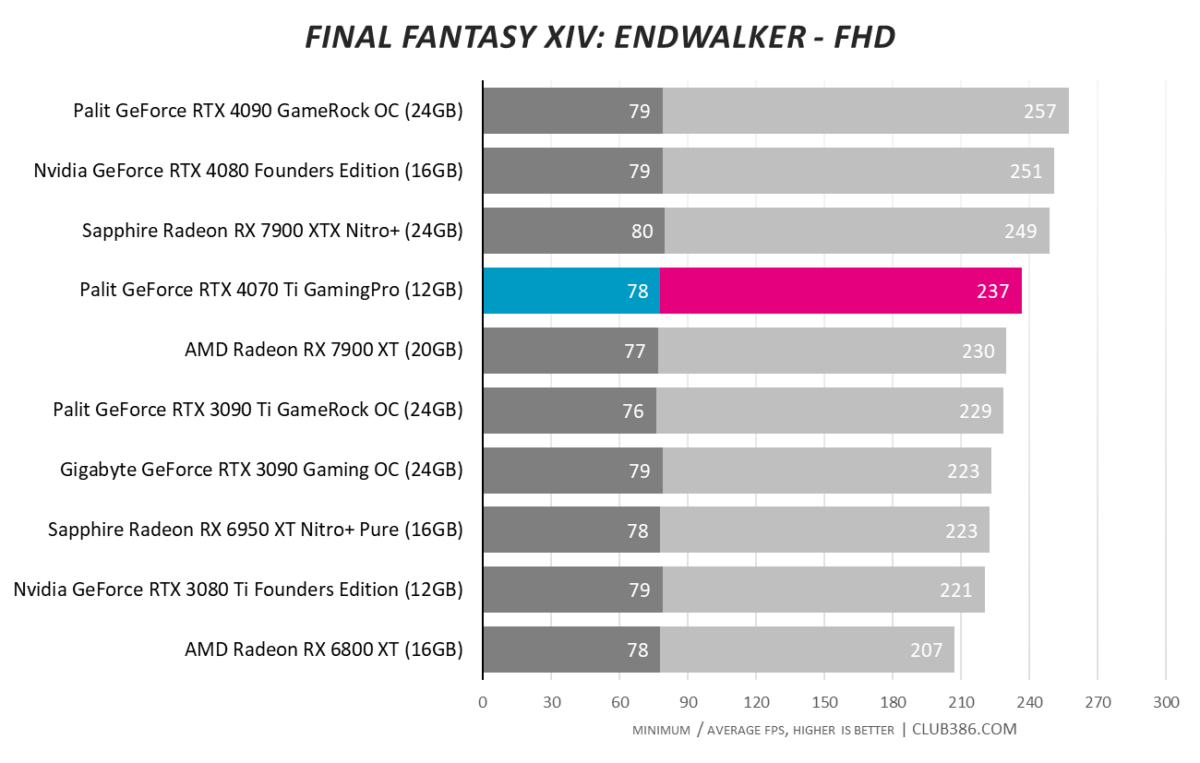
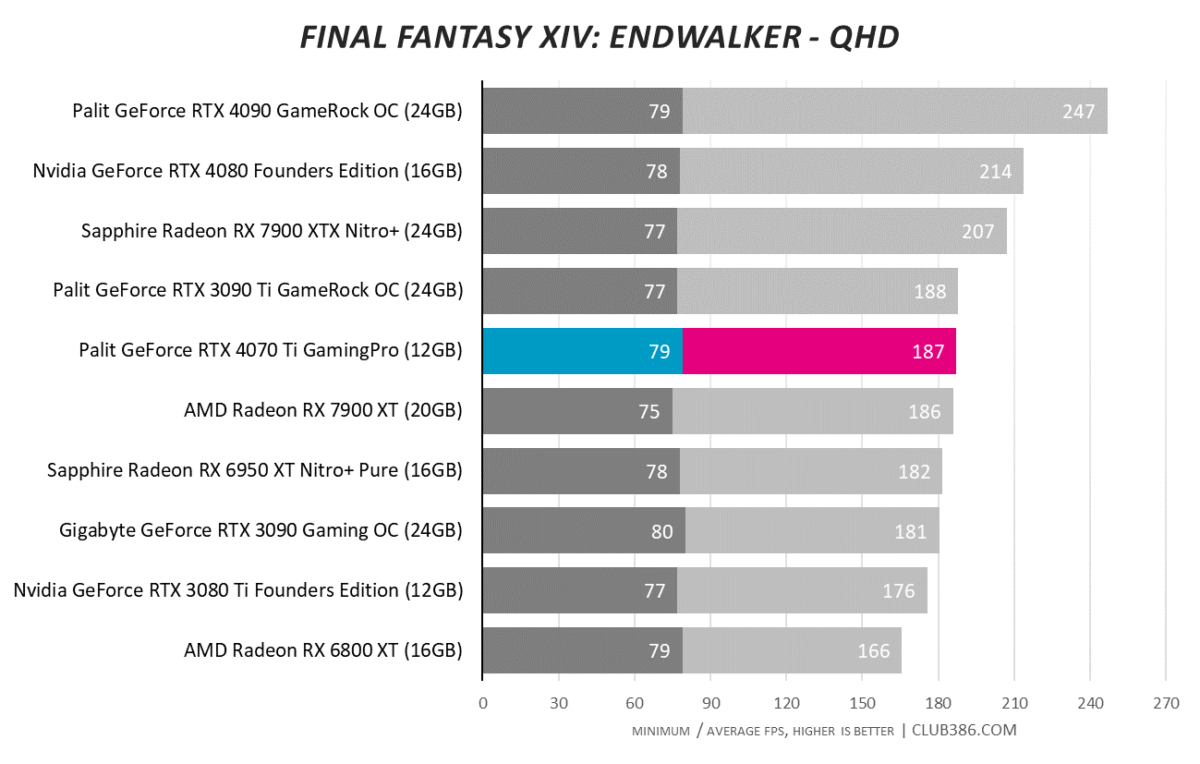
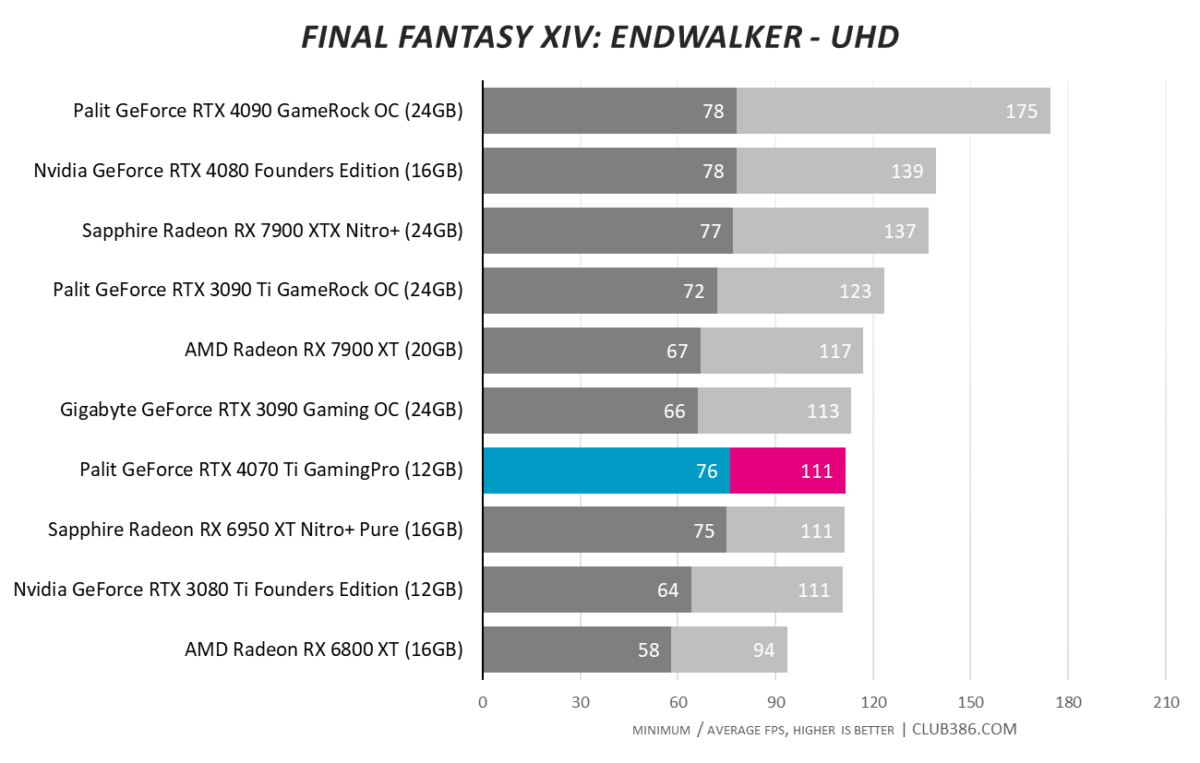
At a QHD resolution, RTX 4070 Ti effectively offers the performance of last-gen RTX 3090 Ti at lower cost and lower power consumption.
Forza Horizon 5
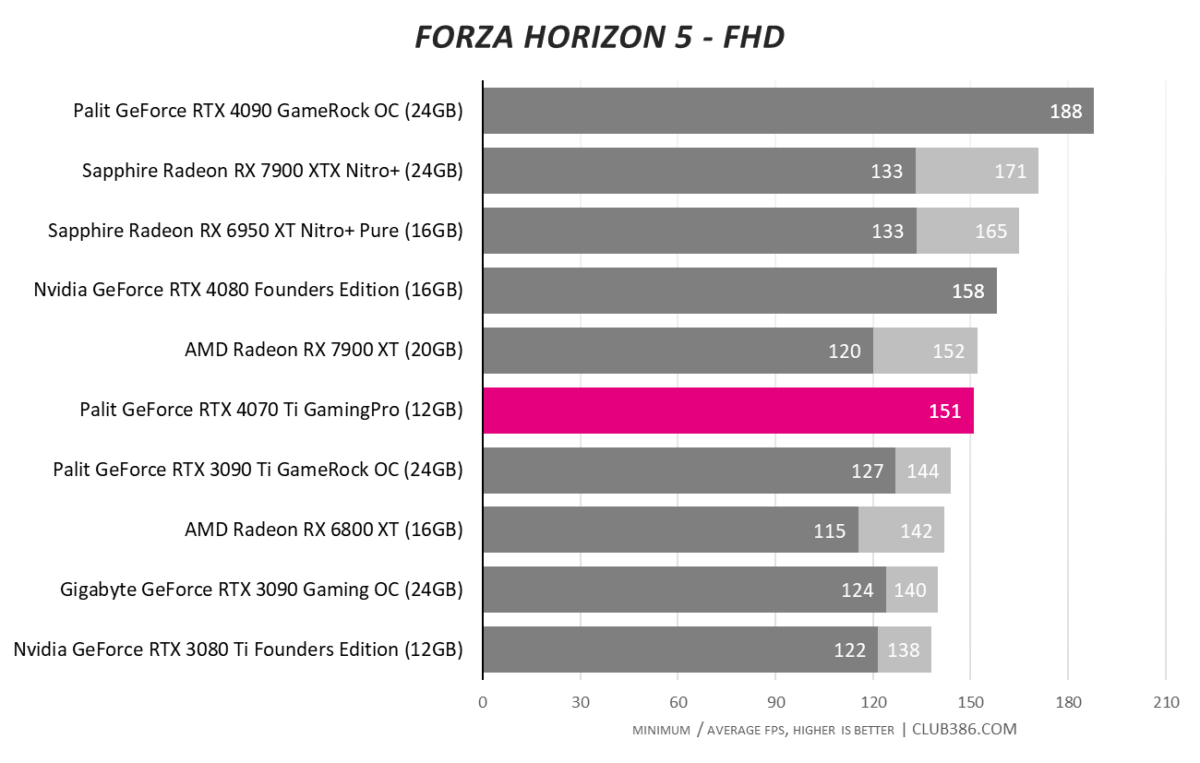
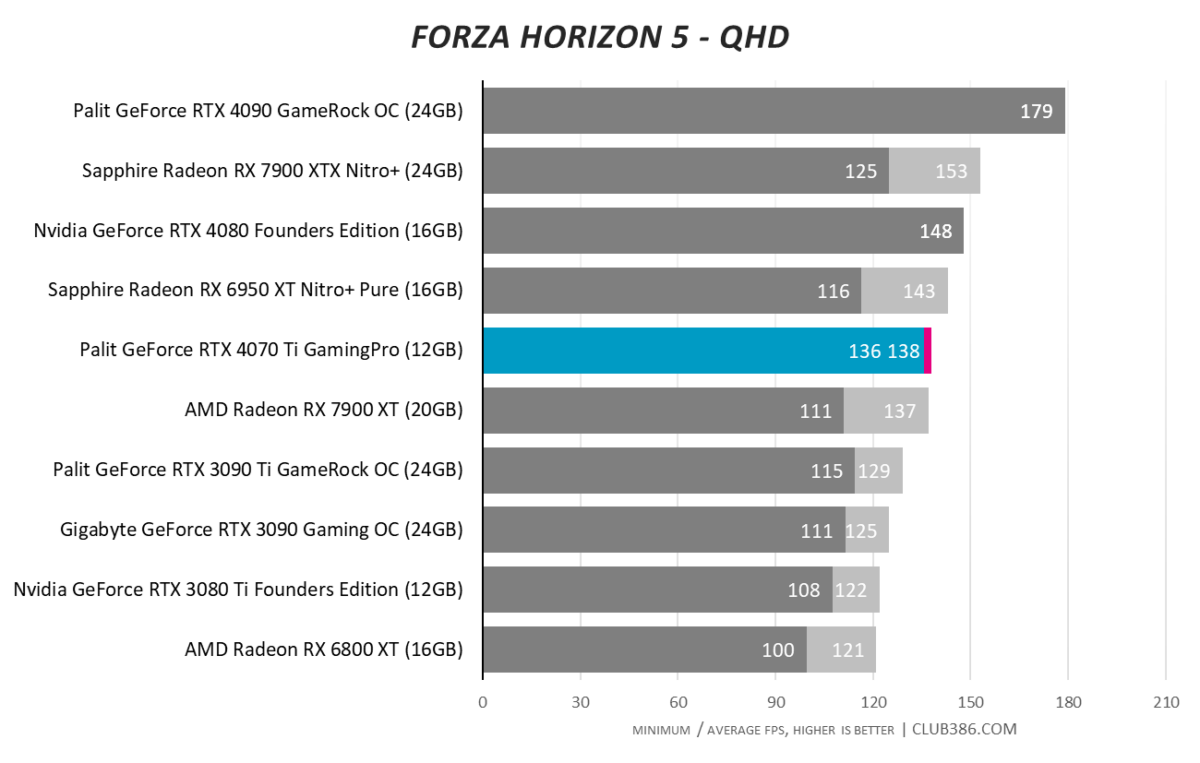
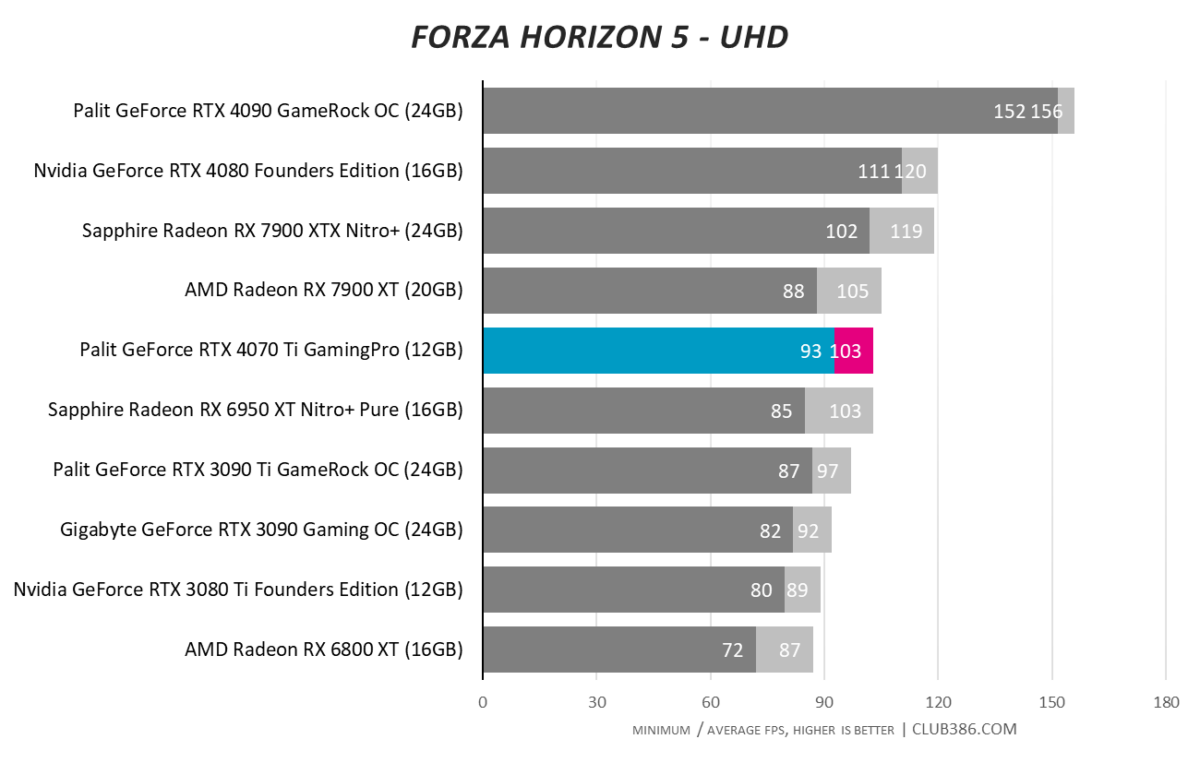
QHD120 is Nvidia’s target and such framerates are often attainable. Note, also, that while RTX 4090 is a freakish headline act, you can get smooth, high-quality 4K visuals for much less.
Marvel’s Guardians of the Galaxy
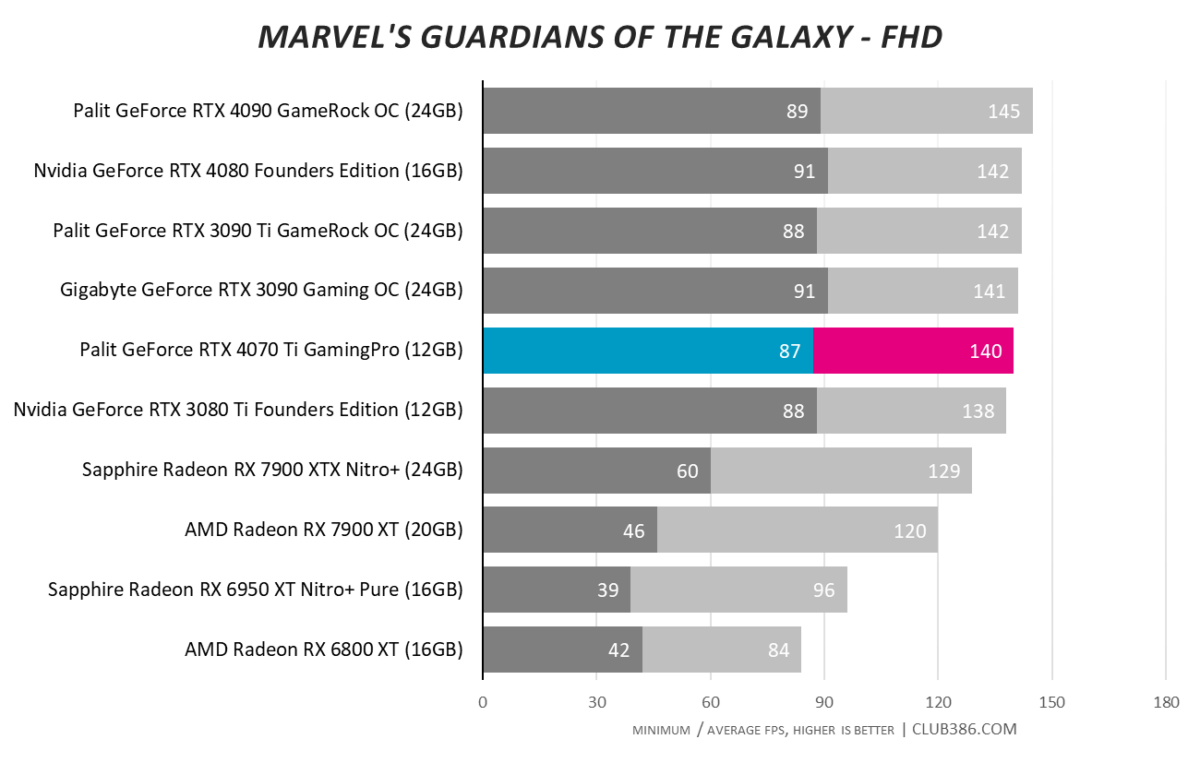
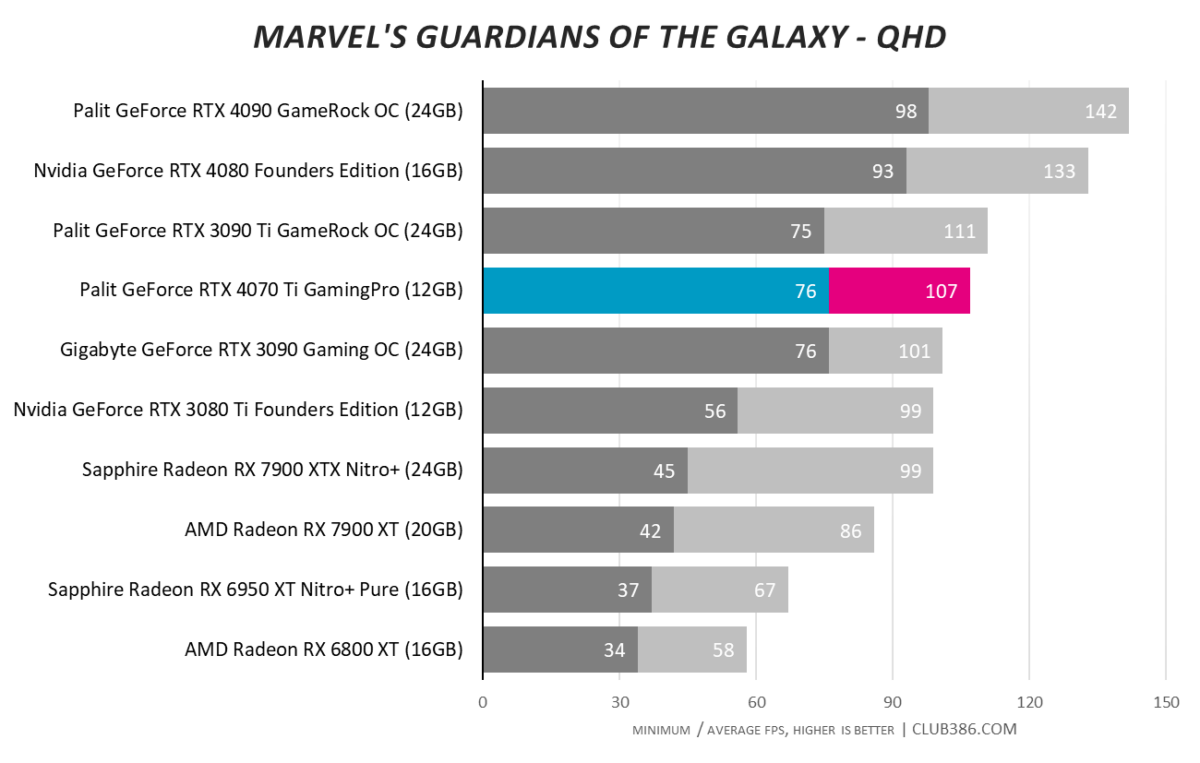
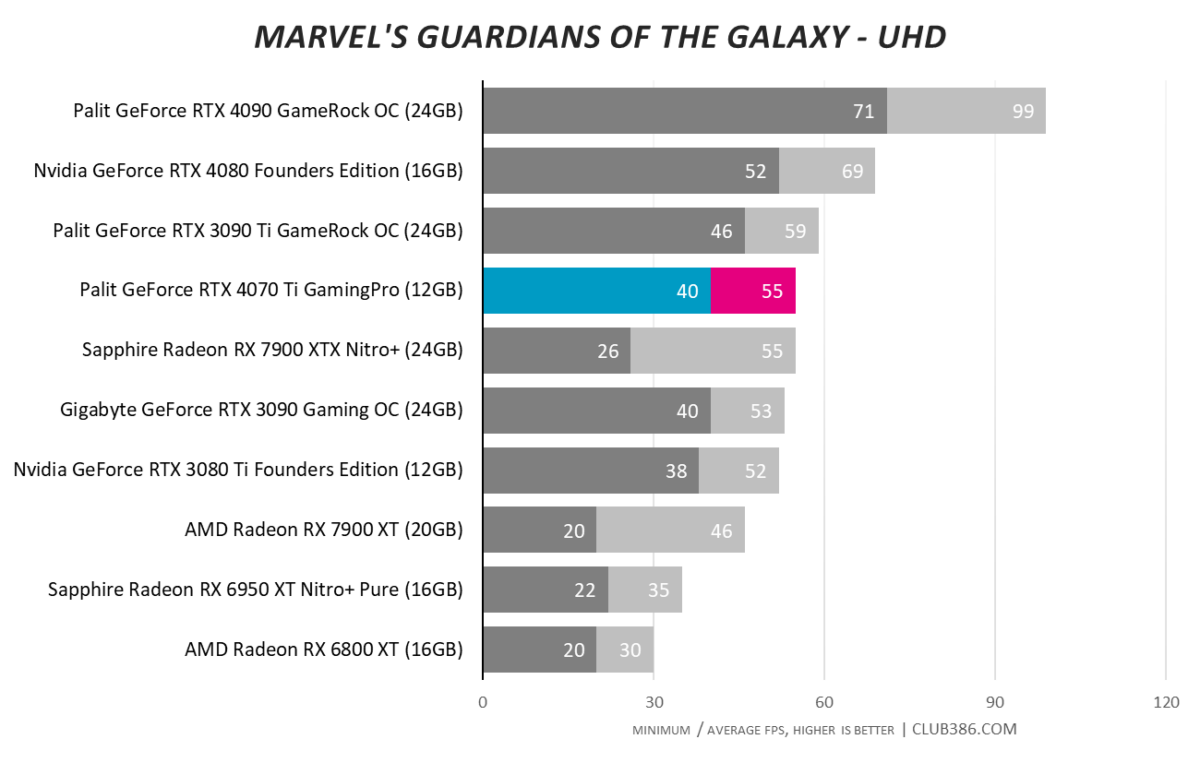
Ray tracing is now a staple of cutting-edge game development, and there’s simply no escaping the fact that GeForce GPUs handle the heightened demands better than anyone else. RTX 4070 Ti is almost 25 per cent quicker than RX 7900 XT in Marvel’s Guardians of the Galaxy at a QHD resolution with ray-traced reflections set to ultra.
Tom Clancy’s Rainbow Six Extraction
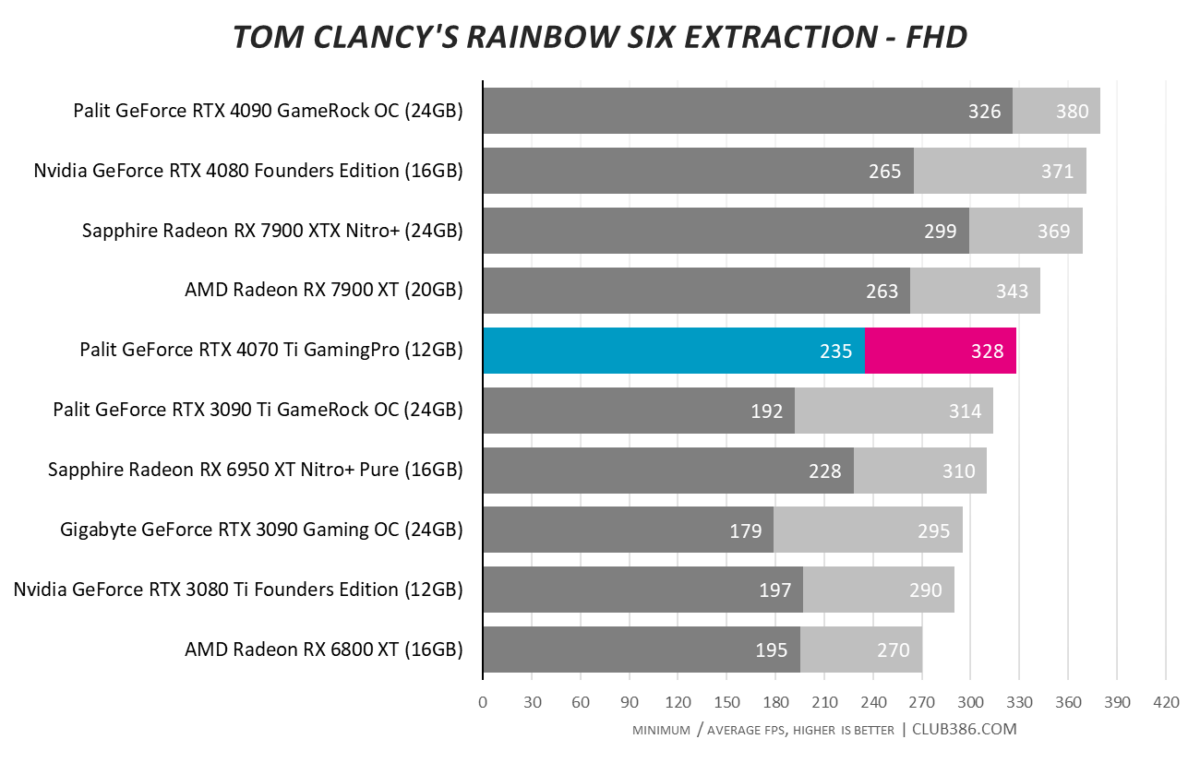
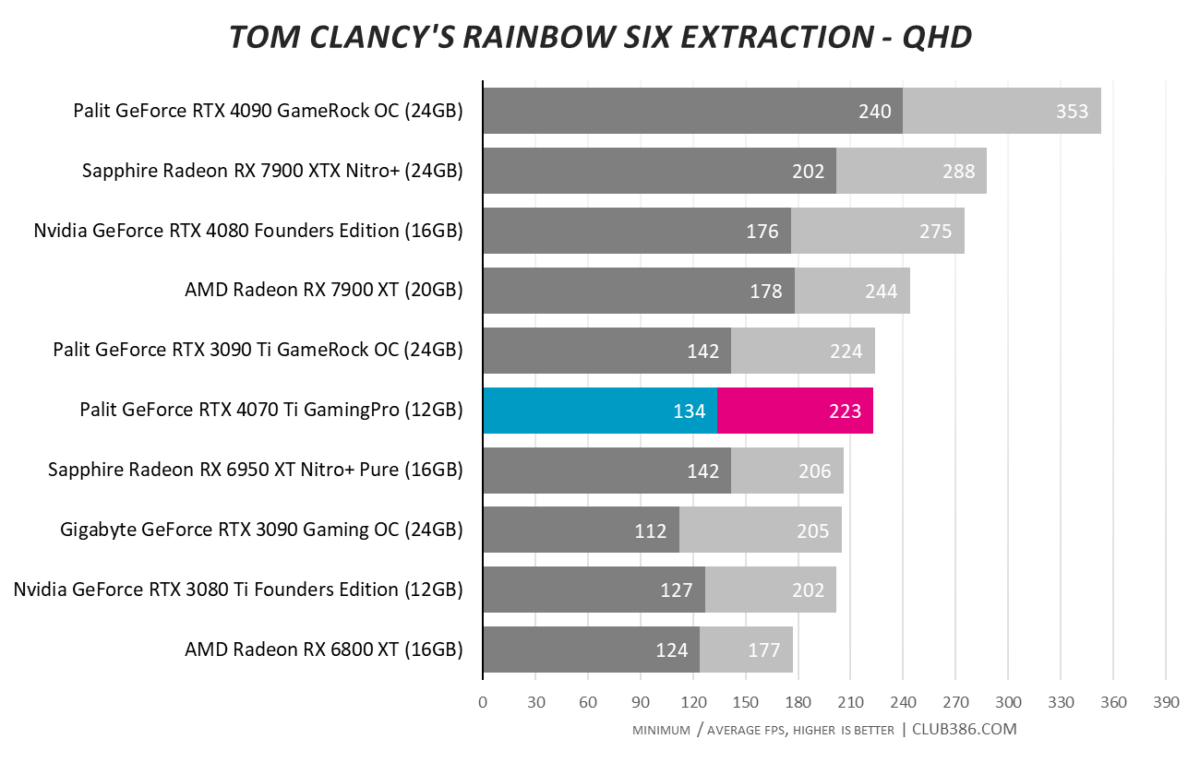
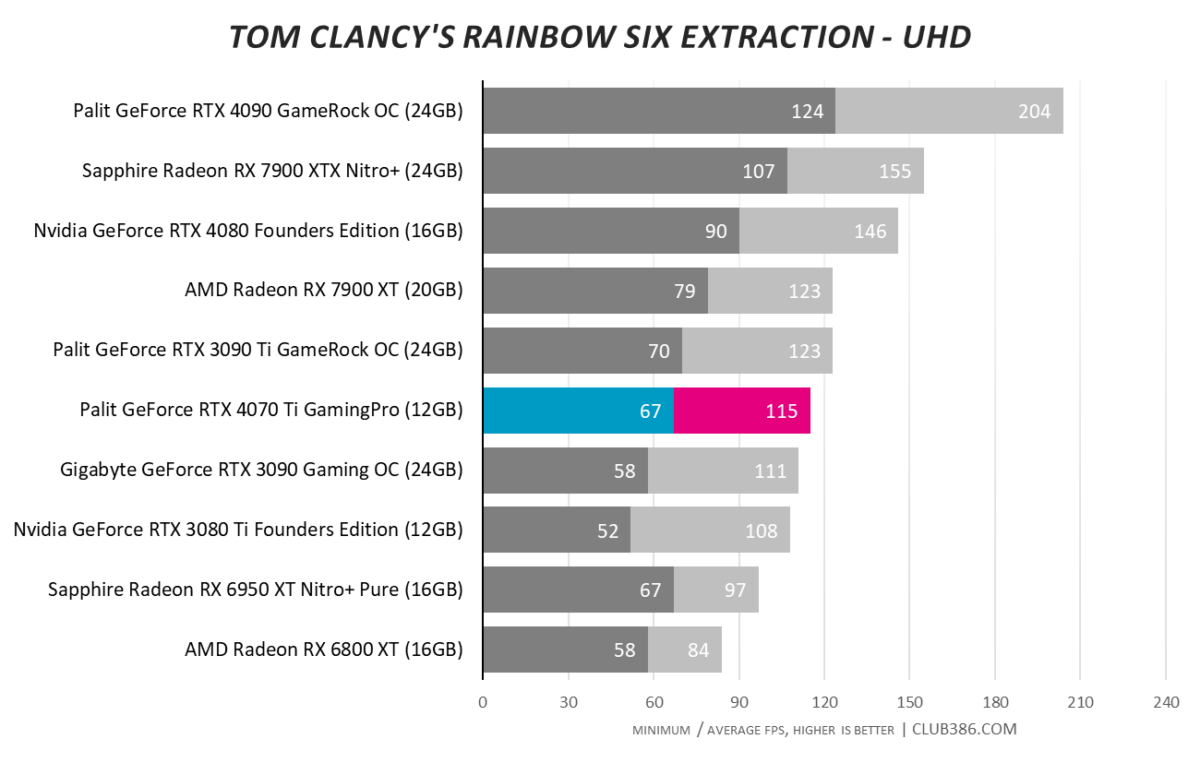
At £899, RTX 4070 Ti risked being overshadowed by RX 7900 XT. £799 is better, but £699 might have had people queueing at the door. Hell, £599 and there’d have been a stampede, both at retailers and among Nvidia’s shareholders.
Power, Temps and Noise
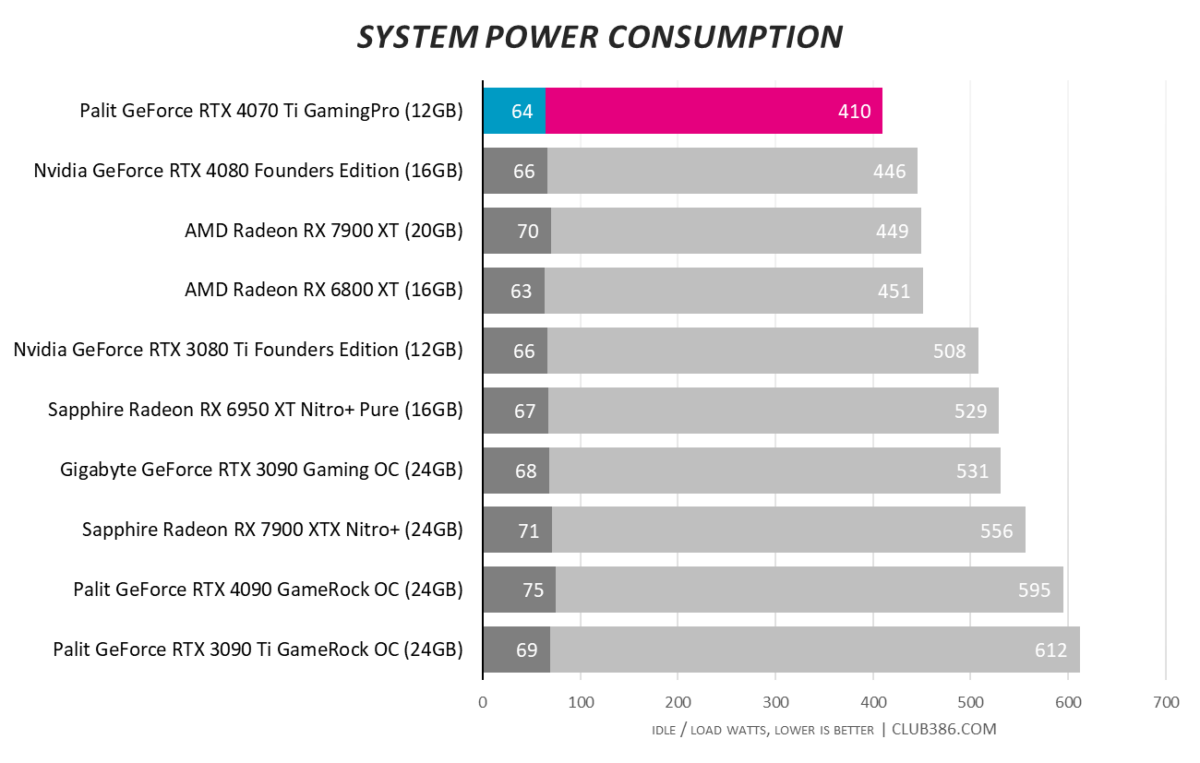
All-new RTX 4070 Ti and previous-gen RTX 3090 Ti may behave similarly in most games, yet the juxtaposition of these two GPUs is clear in other areas. Whereas the latter raises system-wide power consumption to over 600 watts, the Ada Lovelace card delivers that same level of punch in a far more elegant way. Good Better news for the energy bill.
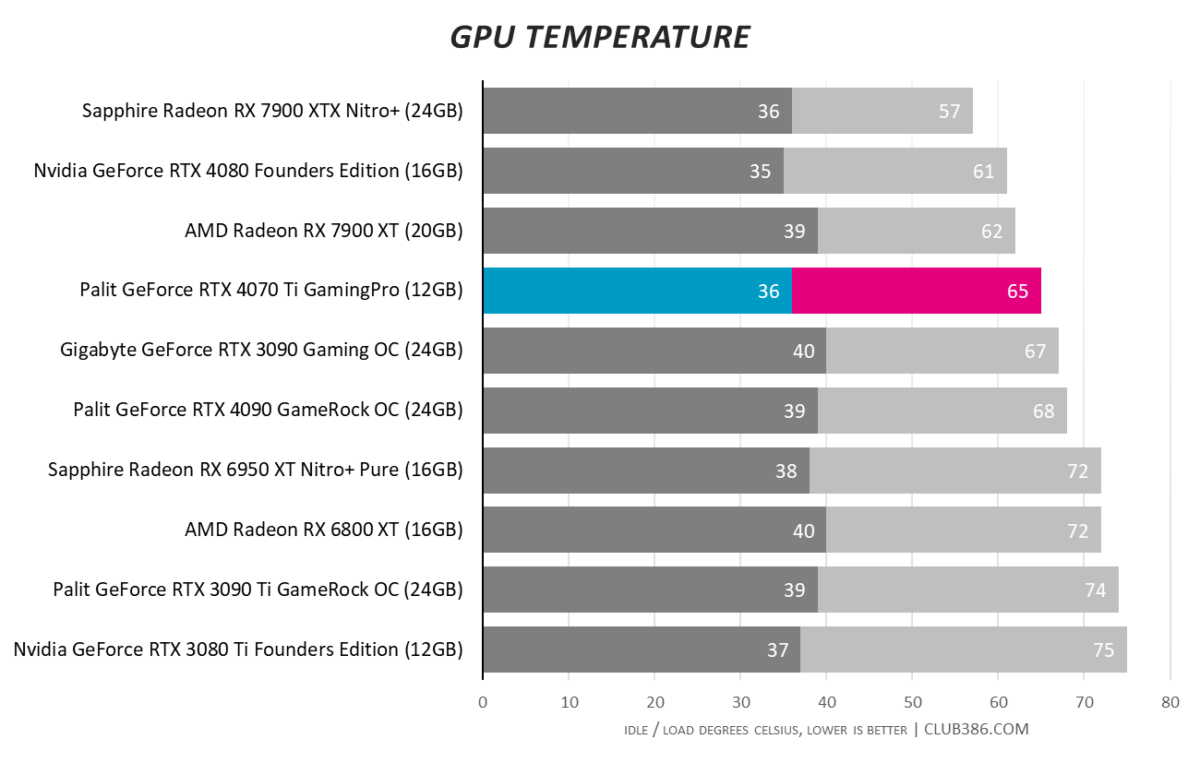
Every partner card ought to be able to deliver sub-70°C temperatures with ease. Cooling performance is now realistically a secondary concern; feel free to choose the card that’s priced right and aesthetically pleasing to your eye.
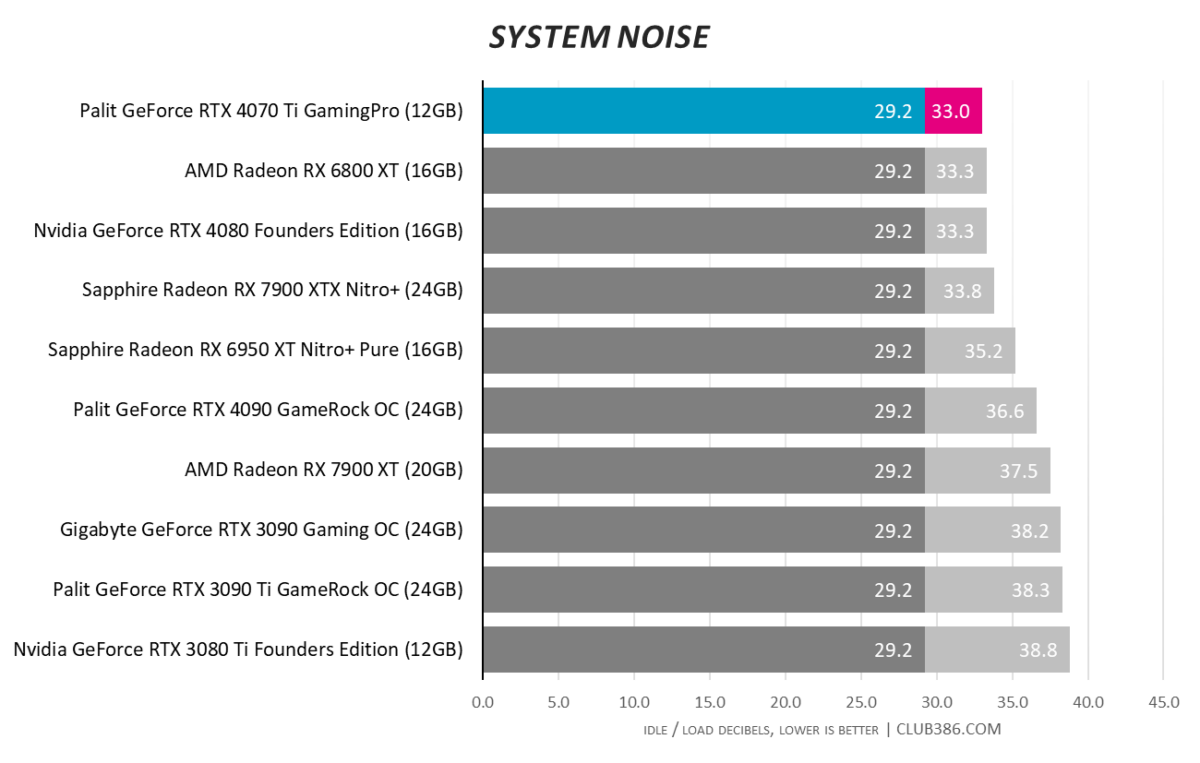
Relatively low power consumption and cool temps should mean little in the way of noise. Palit delivers with a GamingPro card that is barely noticeable even in a quiet room. Top marks here.
Relative Performance
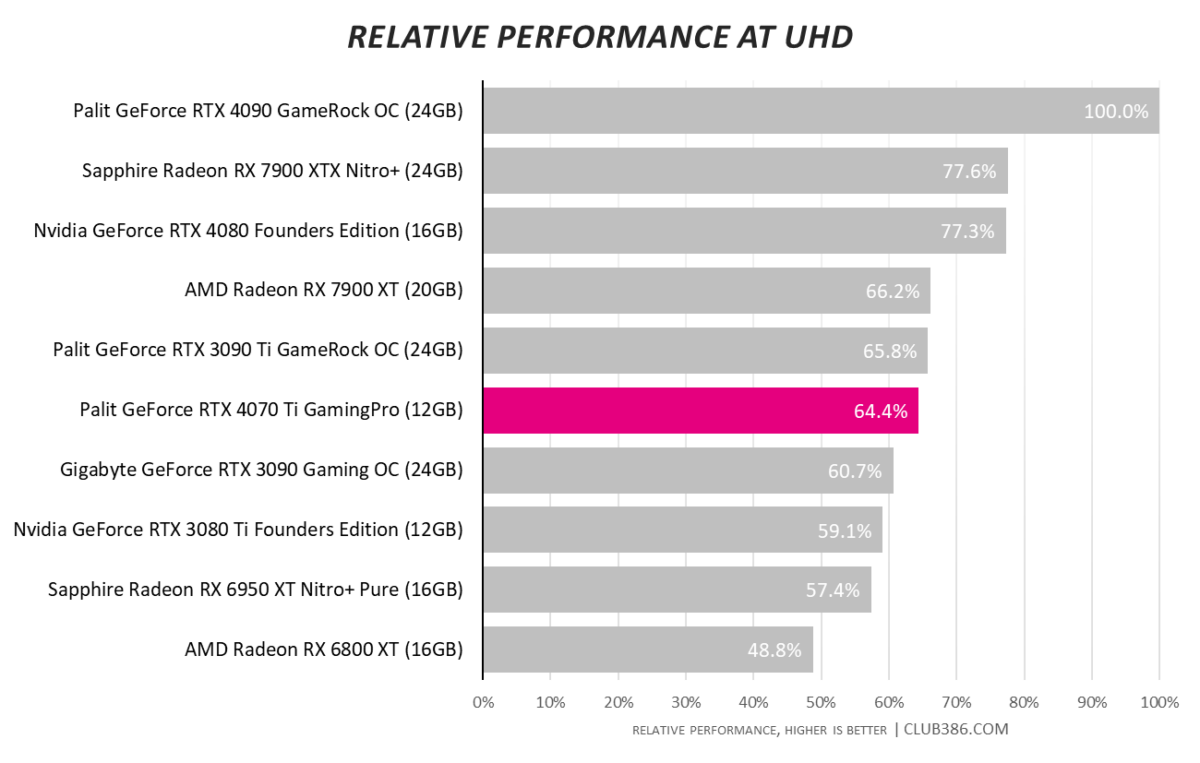
Averaging performance across all our tested games at a 4K resolution puts the $799 RTX 4070 Ti fractionally behind the $899 RX 7900 XT.
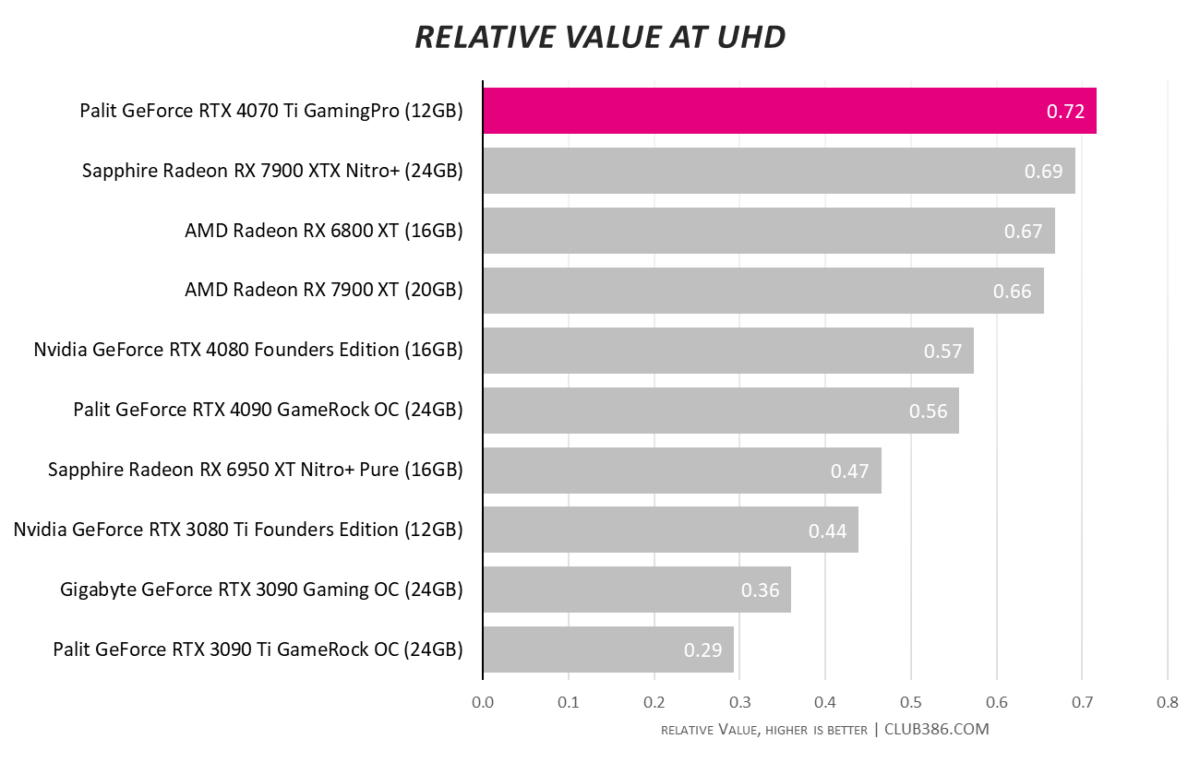
AMD laid down a marker, Nvidia has responded. Dividing average 4K performance by GPU MSRP puts RTX 4070 Ti at the top of the pile. The readjustment to $799 is significant; a score of 0.64 at $899 would have left Nvidia trailing the rival Radeon RX 7900 XT.
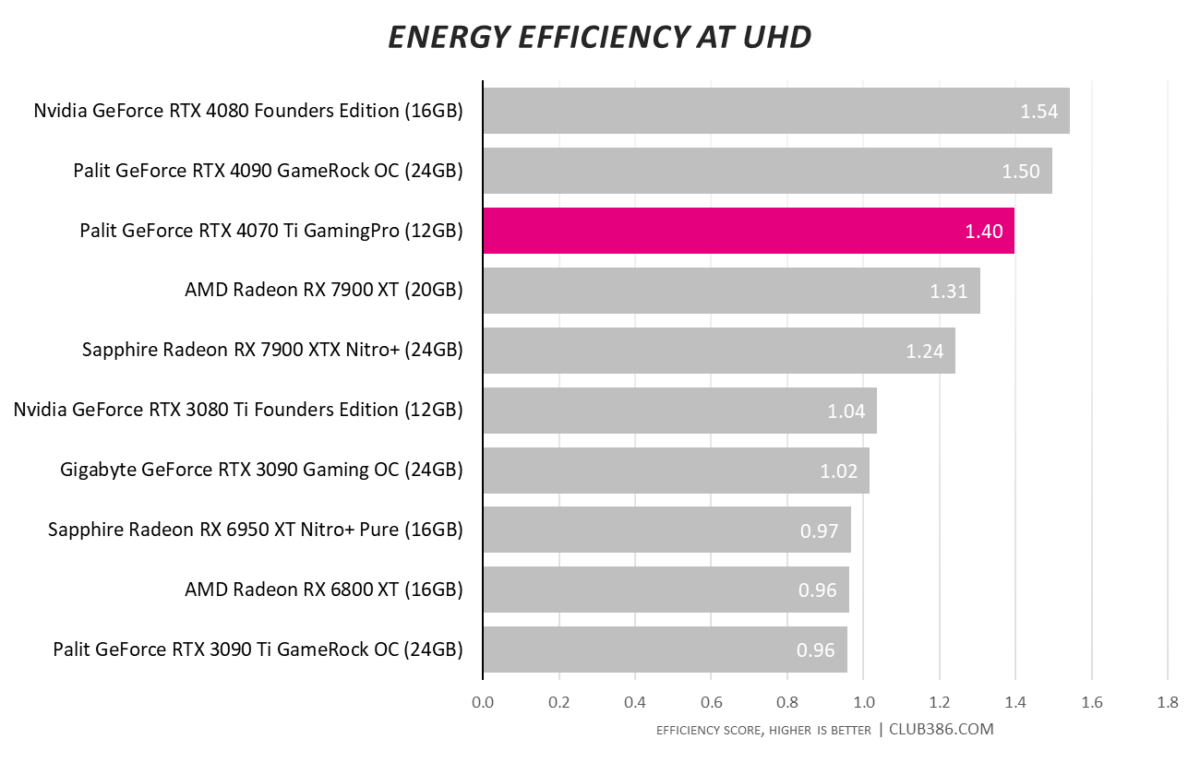
The impressive efficiency of Ada Lovelace architecture is reflected in RTX 40 Series GPUs now claiming gold, silver and bronze when we divide average framerate by system-wide power consumption.
DLSS 3
Having spent the past few decades evaluating GPUs in familiar fashion, it is eye-opening to witness a sea change in how graphics performance is both delivered and appraised.
Thunderous rasterisation and lightning RT Cores, yet DLSS 3 is the storm that’s brewing
RTX 40 Series may boast thunderous rasterisation and lightning RT Cores, yet DLSS 3 is the storm that’s brewing. Rejogging the memory banks after all those benchmarks, remember developers now have the option to enable individual controls for Super Resolution and/or Frame Generation. The former, as you’re no doubt aware, upscales image quality based on setting; Ultra Performance works its magic on a 1280×720 render, Performance on 1920×1080, Balanced works at 2227×1253, and Quality upscales from 2560×1440.
On top of that, Frame Generation inserts a synthesised frame between two rendered, resulting in multiple configuration options. Want the absolute maximum framerate? Switch Super Resolution to Ultra Performance and Frame Generation On, leading to a 720p upscale from which whole frames are also synthesised.
Want to avoid any upscaling but willing to live with frames generated from full-resolution renders? Then turn Super Resolution off and Frame Generation On. Note that enabling the latter automatically invokes Reflex; the latency-reducing tech is mandatory, once again reaffirming the fact that additional processing risks performance in other areas.
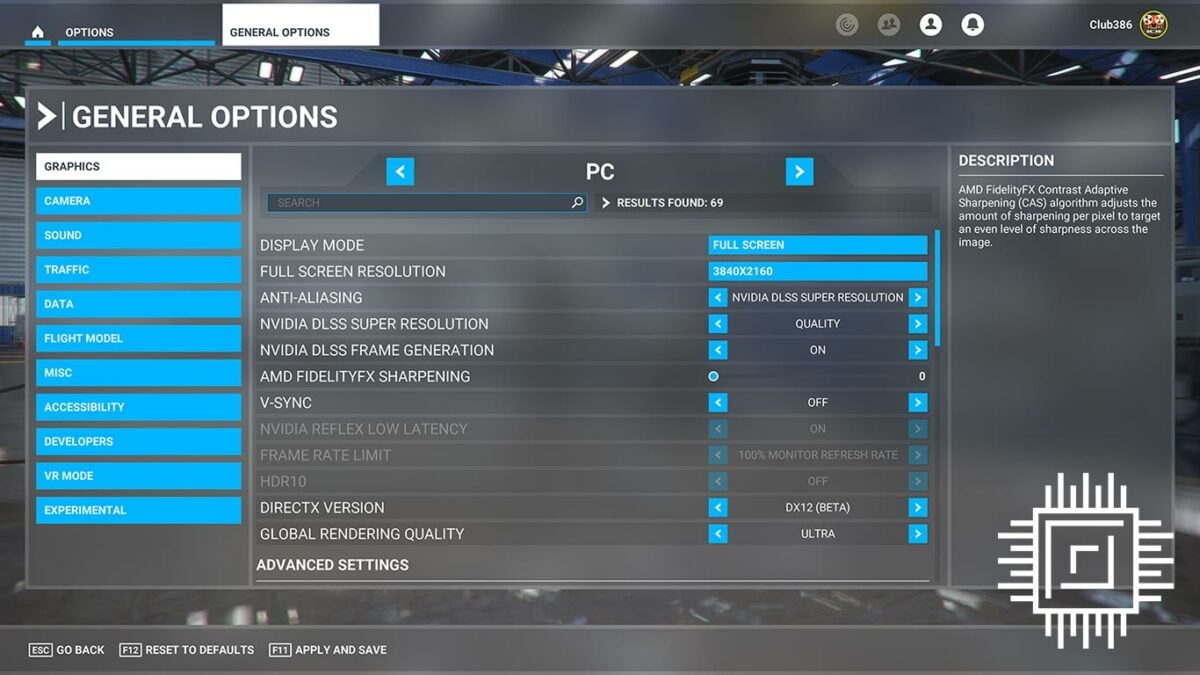
Reviewers have been granted access to pre-release versions of select titles incorporating DLSS 3 tech. Initial impressions are that developers are still getting to grips with implementation. Certain games require settings to be enabled in a particular sequence for DLSS 3 to properly enable, while others simply crash when alt-tabbing back to desktop. There are other limitations, too. DLSS 3 is not currently compatible with V-Sync (FreeSync and G-Sync are fine) and Frame Generation only works with DX12.
Point is, while Nvidia reckons uptake is strong – some 35 DLSS 3 games have already been announced – these are early days, and some implementations will work better than others. Microsoft Flight Simulator is one of the first to officially support DLSS 3 as part of Sim Update XI (SU11, pictured above), and the results are dramatic to say the least.
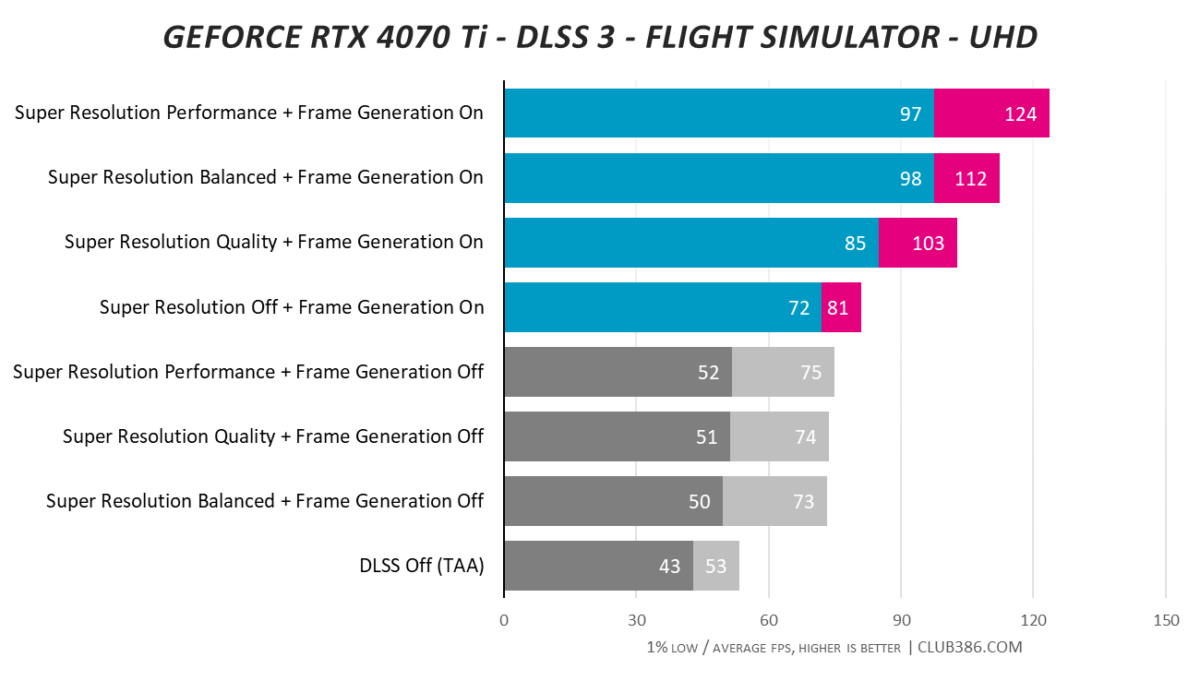
RTX 4070 Ti is benchmarked at a 4K UHD resolution with ultra rendering quality. With DLSS disabled entirely, the GPU falls short of our preferred 60fps target in the Sydney Famous Landing Challenge.
Enabling Super Resolution (DLSS 2) to either quality, balanced or performance modes lifts performance by almost 40 per cent, but it is Frame Generation (DLSS 3) that continues to astonish. Turning it independently boosts performance by 53 per cent, climbing to 94 per cent when Super Resolution is added to the mix at maximum quality.
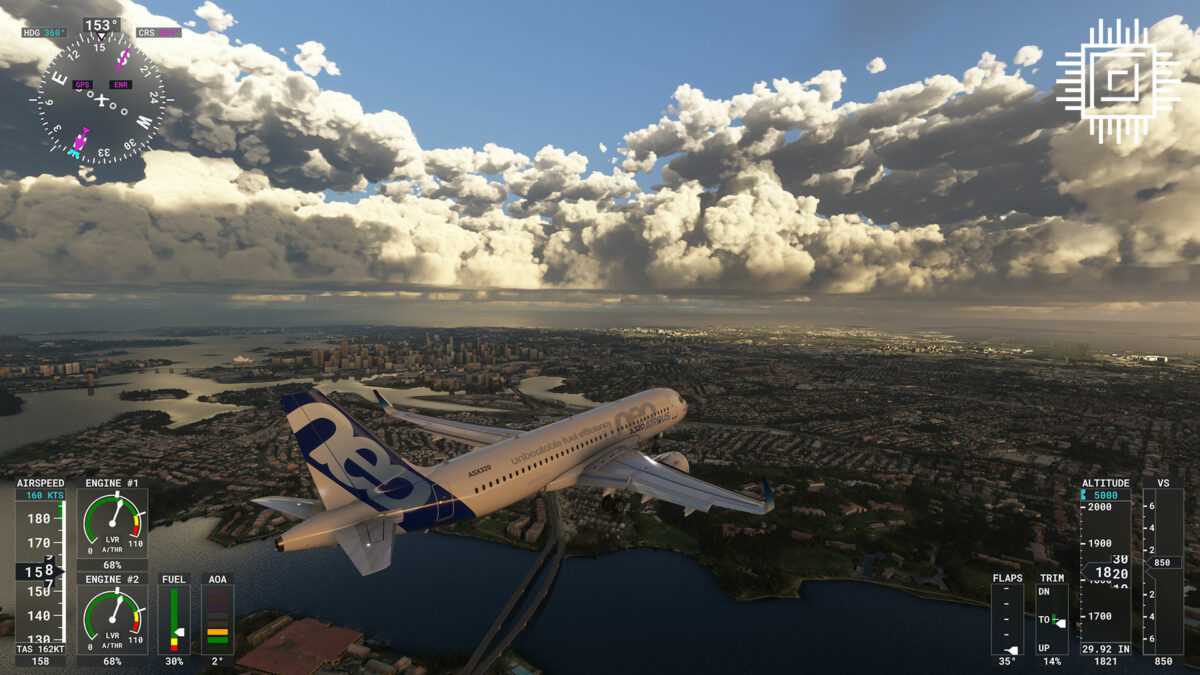

Flight Simulator is an excellent example of where Frame Generation holds merit. This is a tech unlikely to be widely used by competitive gamers who rely on maximum accuracy, but in the right scenario, the framerate gains are simply too large to ignore. With the right monitor, the difference between 4K60 and 4K120 can be profound, and when done well there’s little detriment to image quality.
That isn’t to say it’s perfect – we did notice occasional flickering of elements in the cockpit – but you really have to look for artifacts to know they’re there. Implementation is impressive, even at this early stage, and Nvidia does well to keep latency in check through Reflex. With DLSS disabled entirely, in-game Flight Simulator latency is recorded as 67.1ms. This rises to 75.4ms with Frame Generation enabled, and then drops back down to 66.9ms with Frame Generation and Super Resolution at maximum quality.
It is too soon to deem DLSS 3 a must-have feature, yet make no mistake, it is an important feather in the 40 Series’ cap and one that rivals will be rushing to replicate. Rival AMD Radeon RX 7000 Series promises Fluid Motion Frames in an effort to double 4K framerate, but when exactly the tech will be available, and how well it performs, remains unknown.
Conclusion
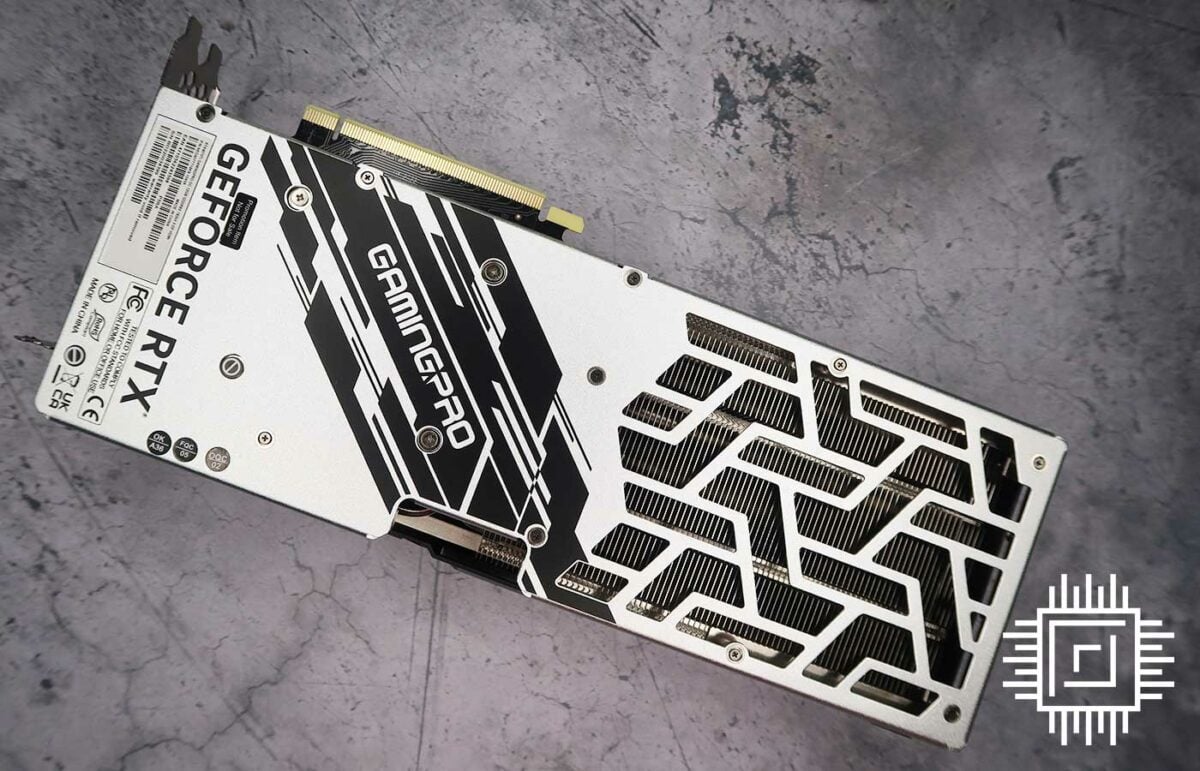
Will GPU prices ever return to archetypal levels? PC gamers living in hope can chalk up the RTX 4070 Ti as a minor victory and step in the right direction.
Though $799 still feels a significant outlay for a QHD solution with 12GB of RAM, Nvidia’s $100 correction is borne out of necessity more than desire. The primary objective is to beat what’s in front of you, and while RTX 4070 Ti falls short of RX 7900 XT in pure rasterisation, superior ray tracing performance, DLSS 3 wizardry and a lower price tag combine to make the GeForce an attractive proposition for anyone contemplating this sort of outlay.
If you can find a way past the pricing burden, the baby of the RTX 40 Series bunch offers in-game performance akin to former flagship, RTX 3090 Ti, in a noticeably more efficient package. Building on those capable foundations, Palit’s GamingPro delivers ultra-low temps, ultra-low noise, and handsome RGB embellishments to create a card that, at the end of the day, makes for an enjoyable gaming experience with quality settings dialled up to maximum.
Verdict: A fine choice for QHD gaming, more memory or an even lower fee would elevate RTX 4070 Ti from good to great.

